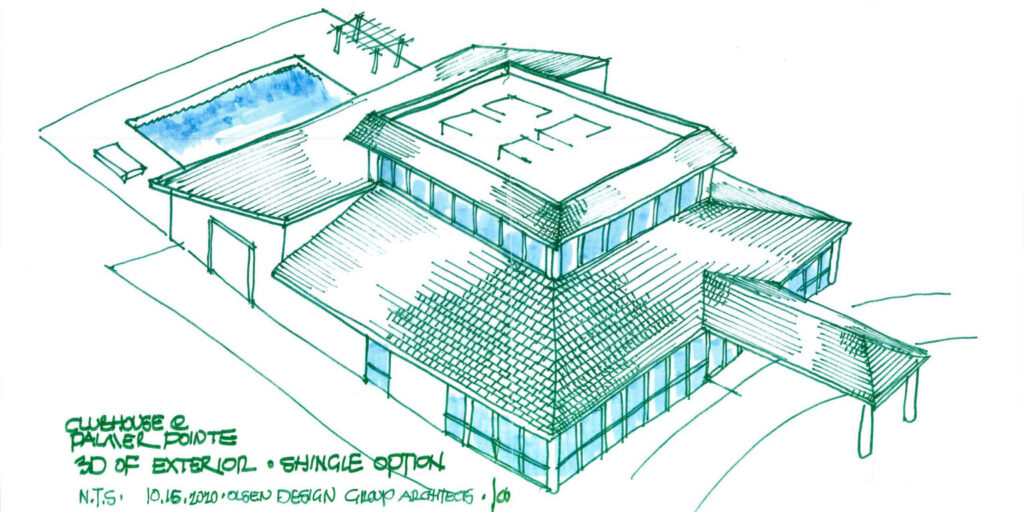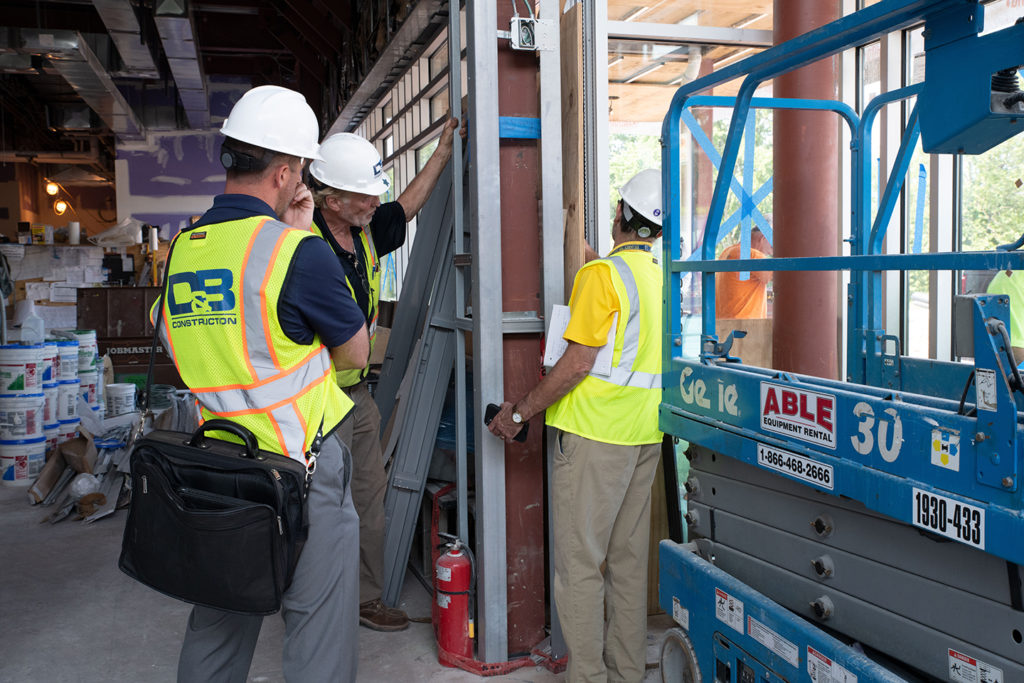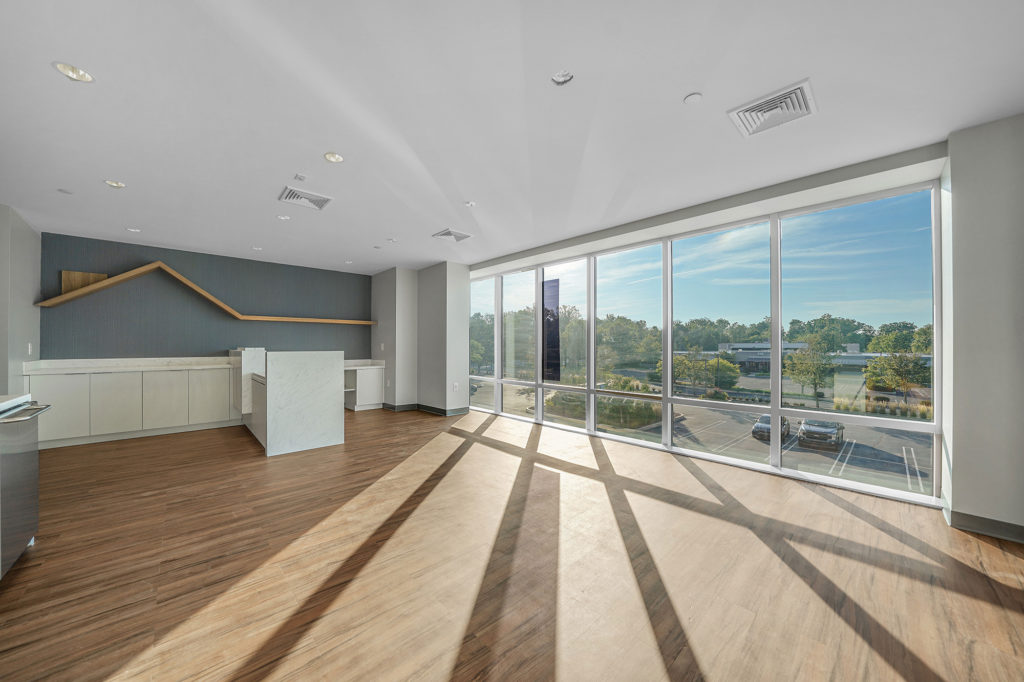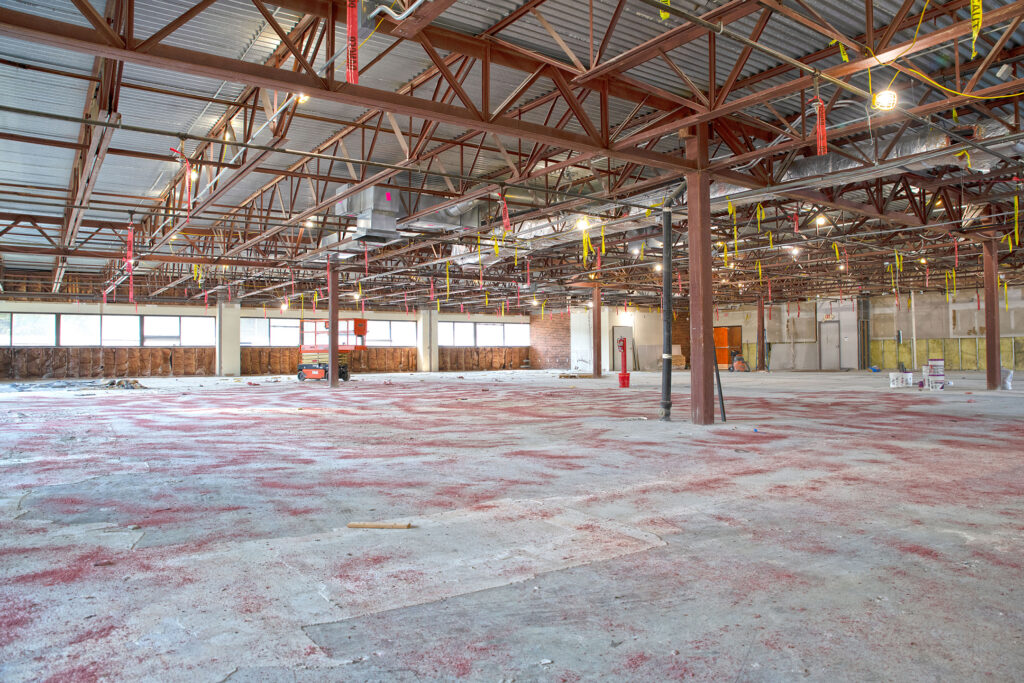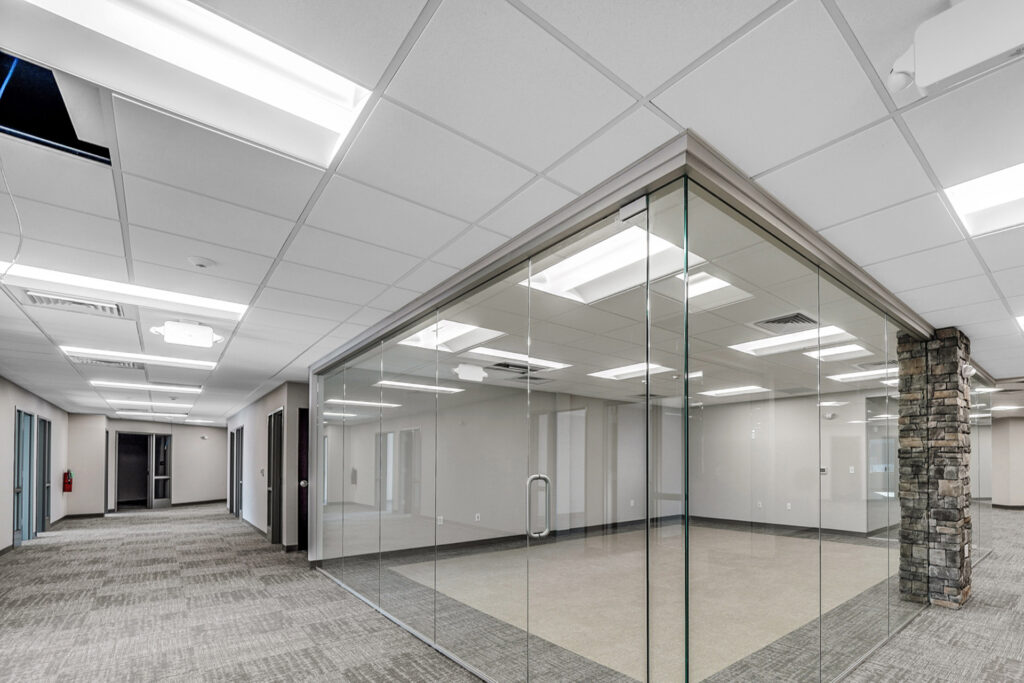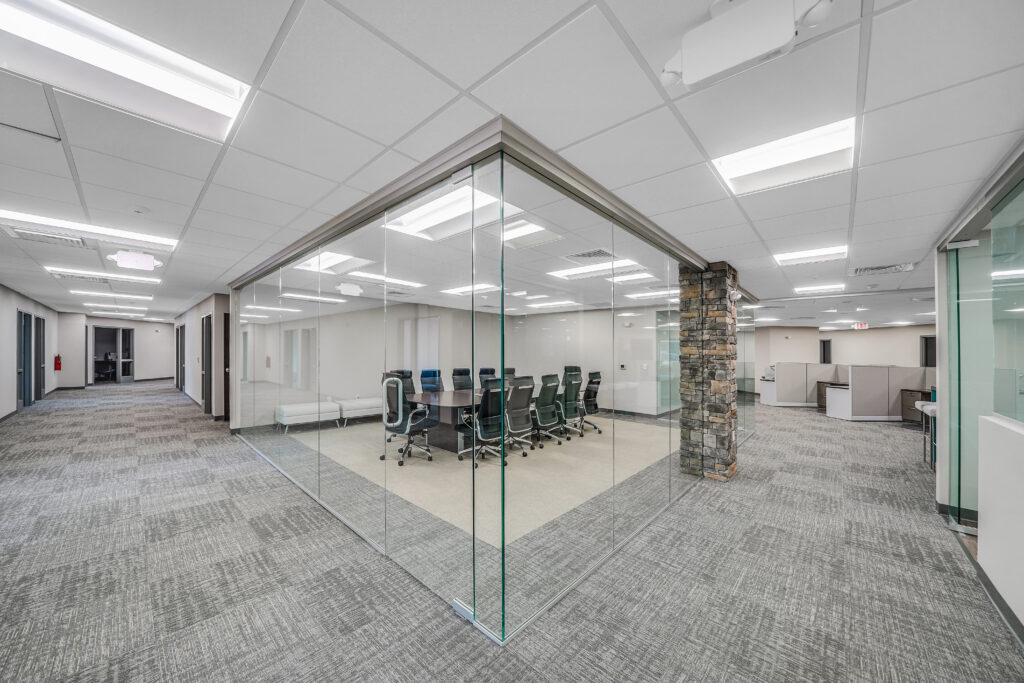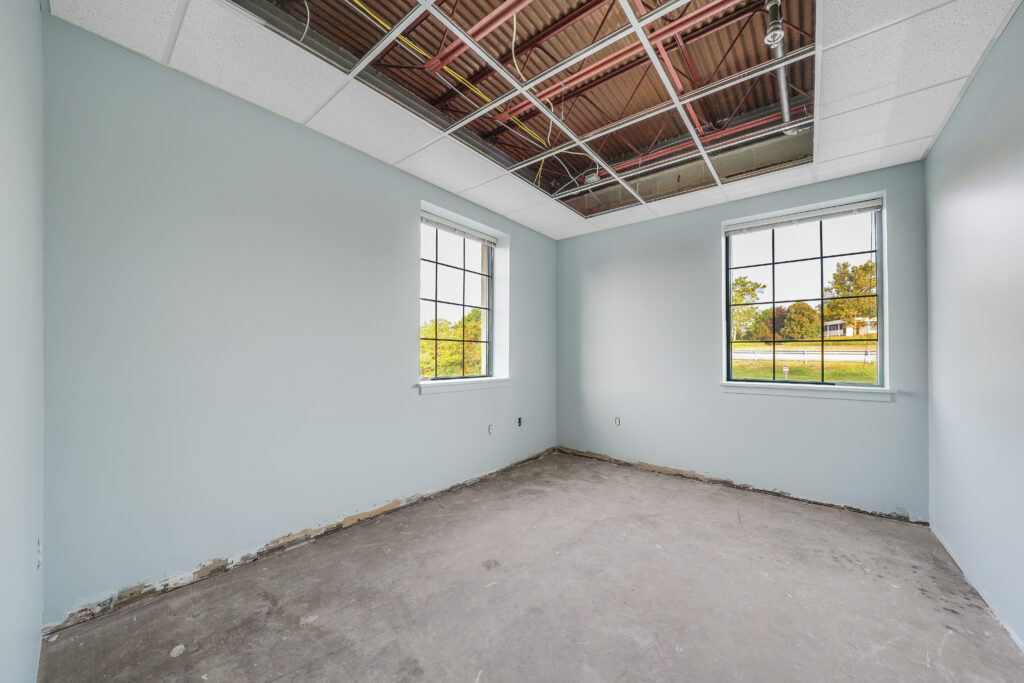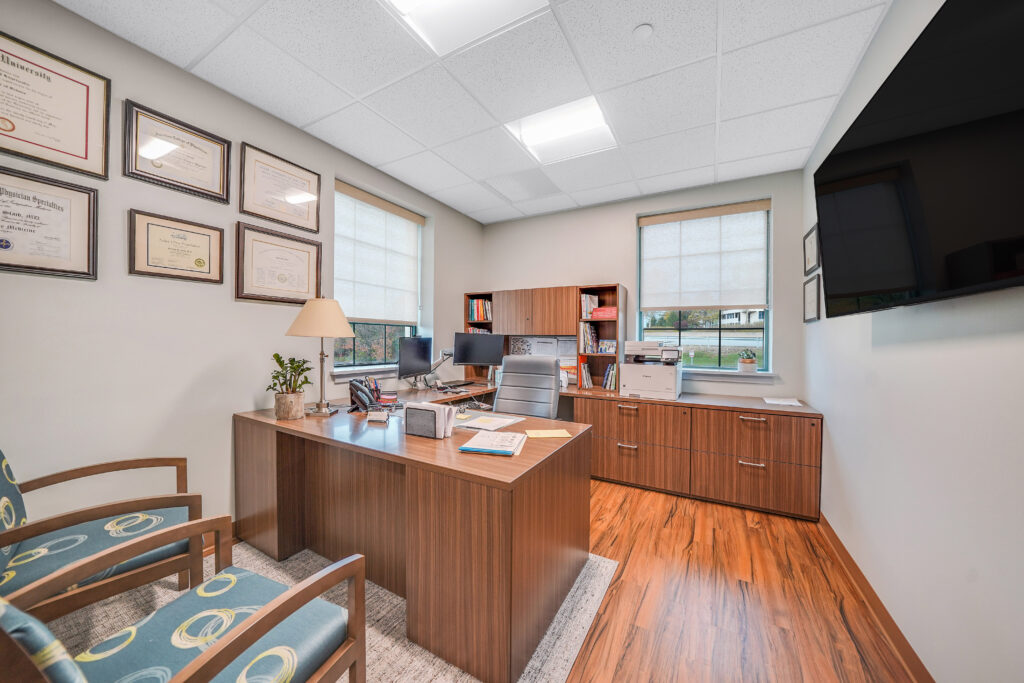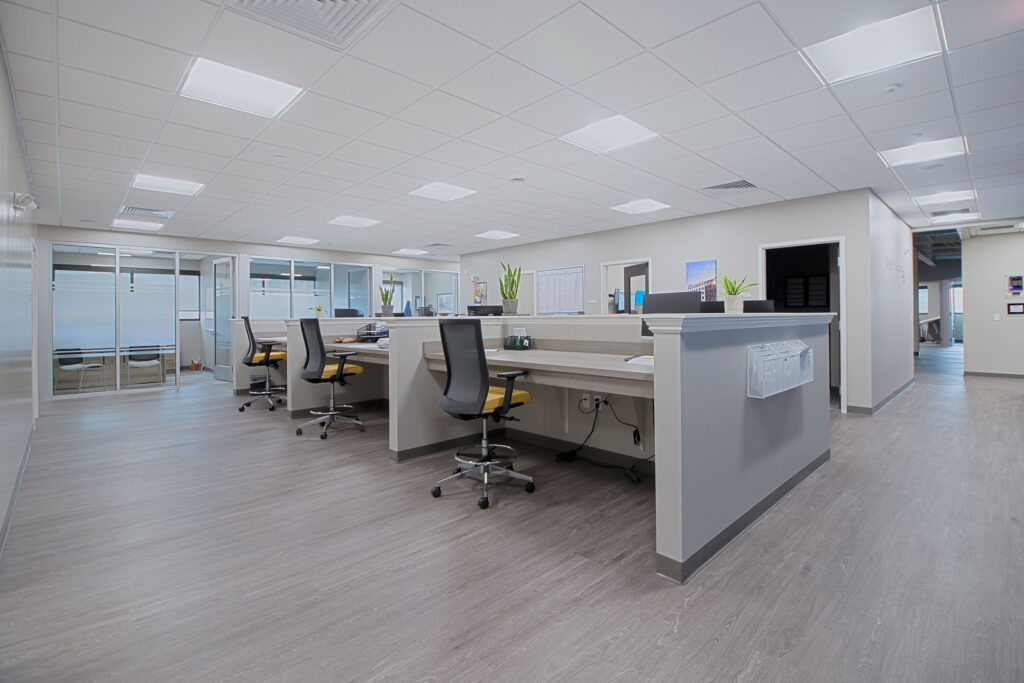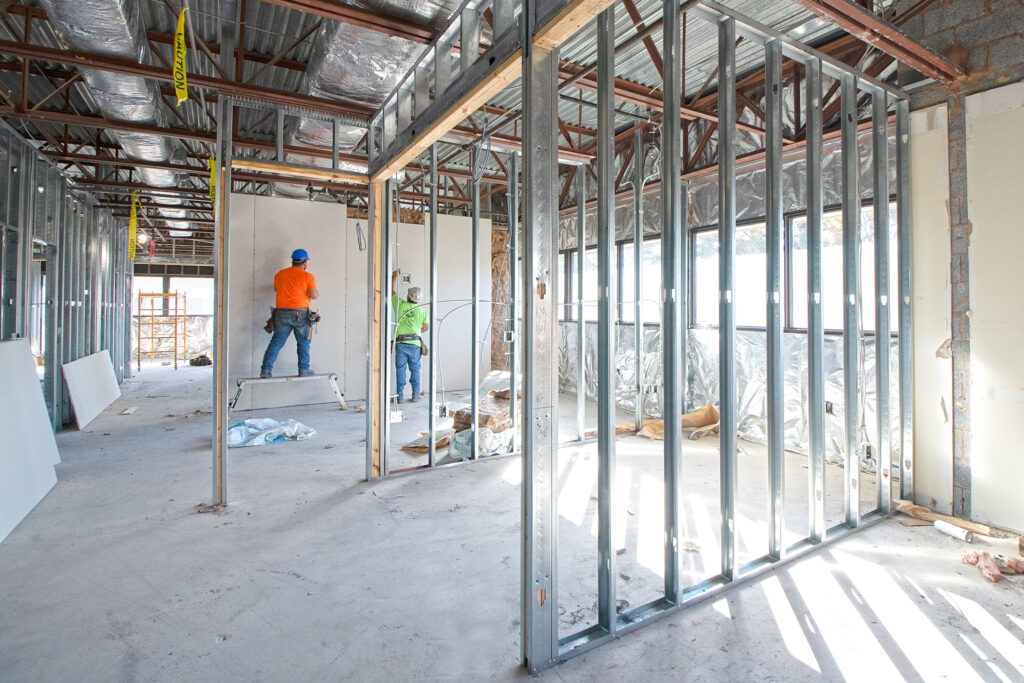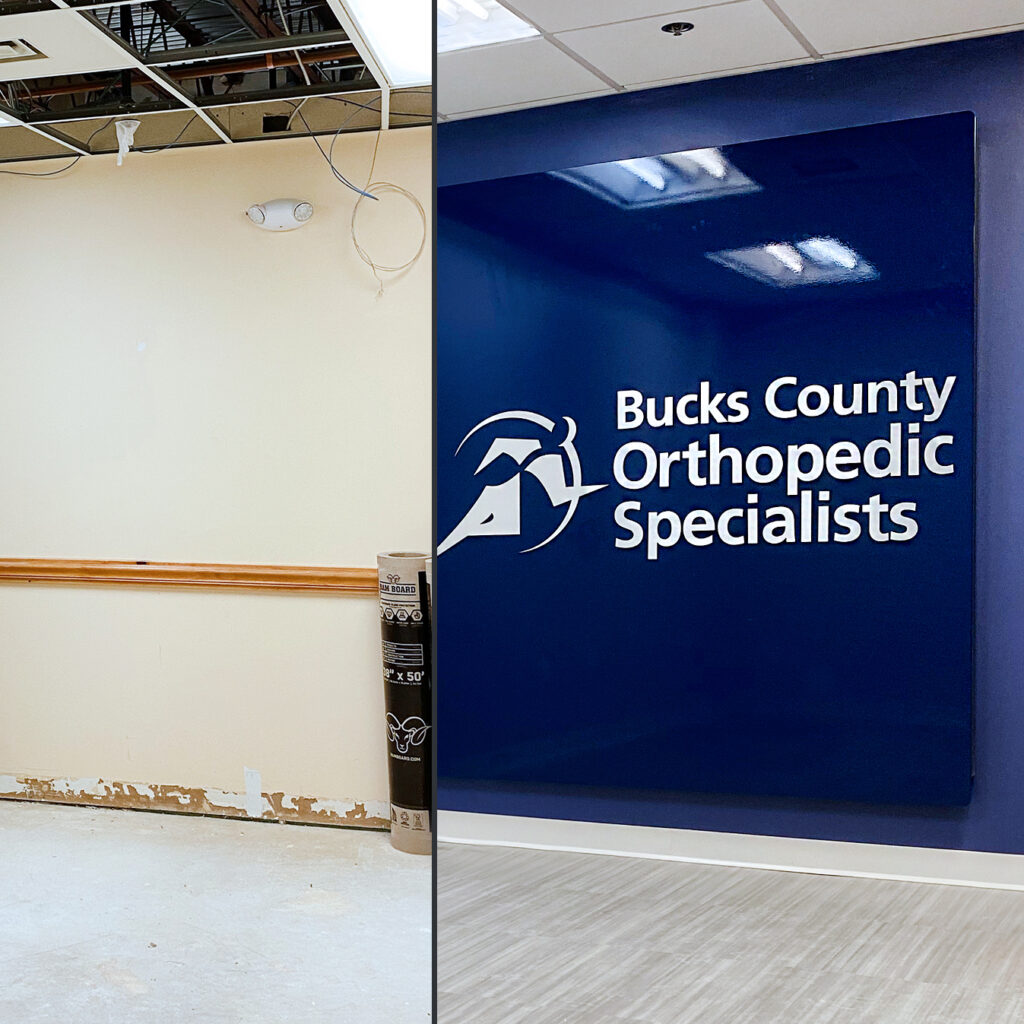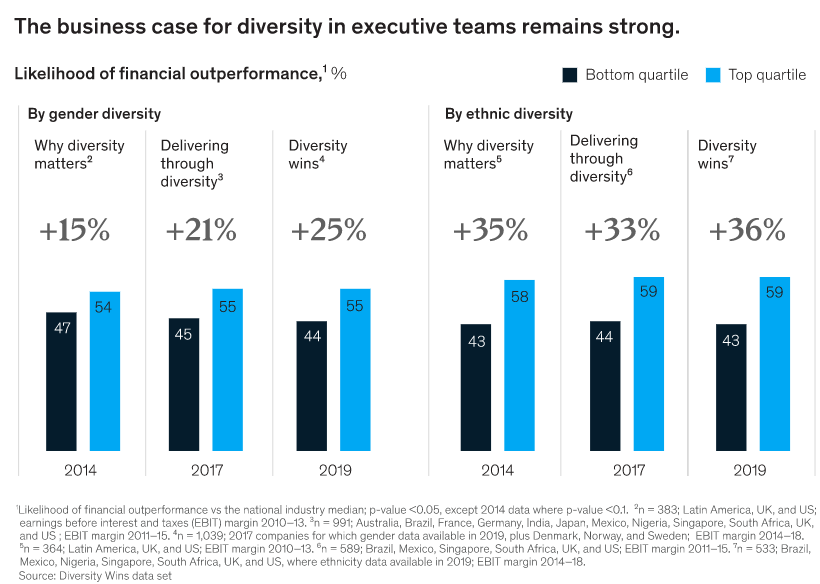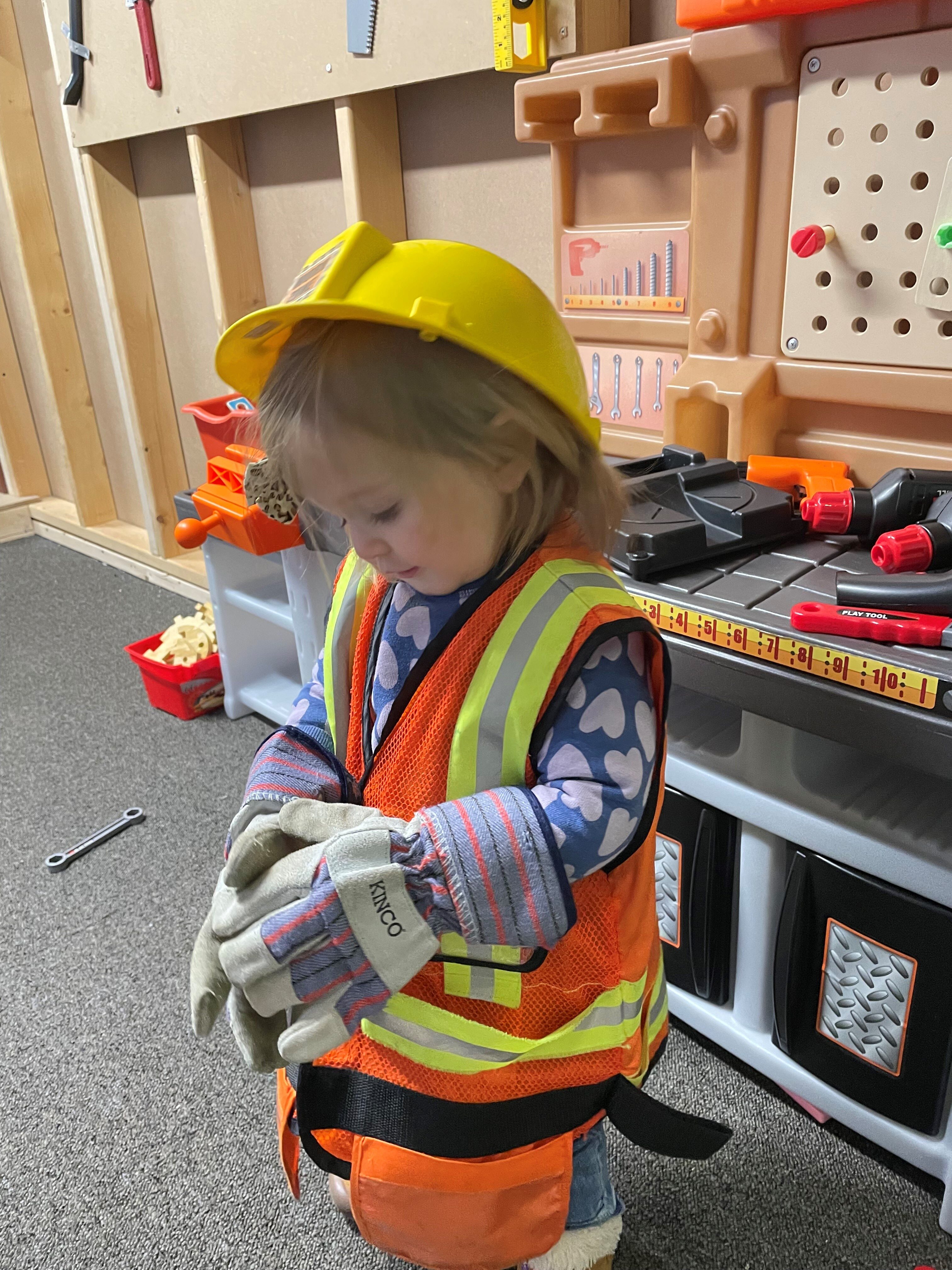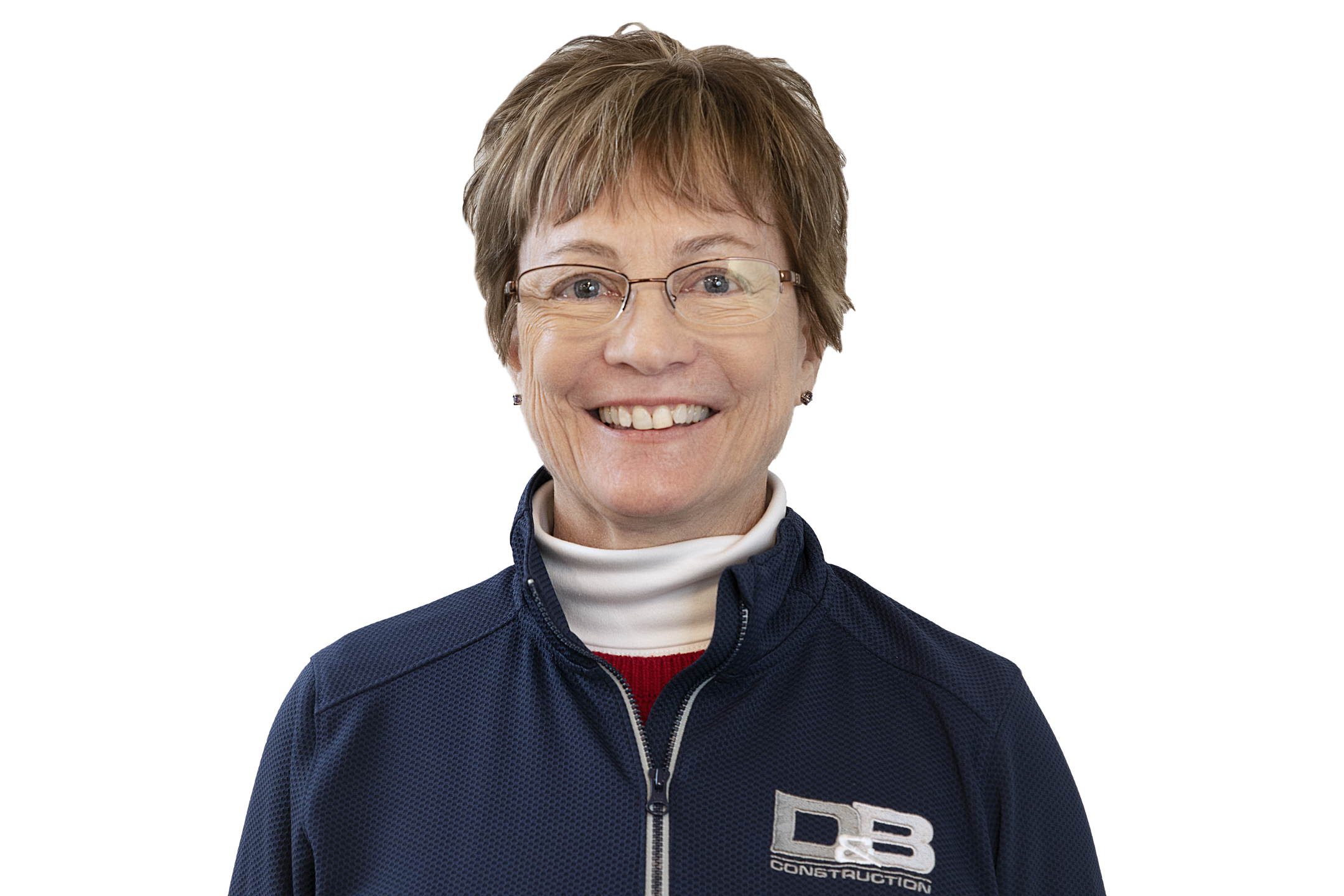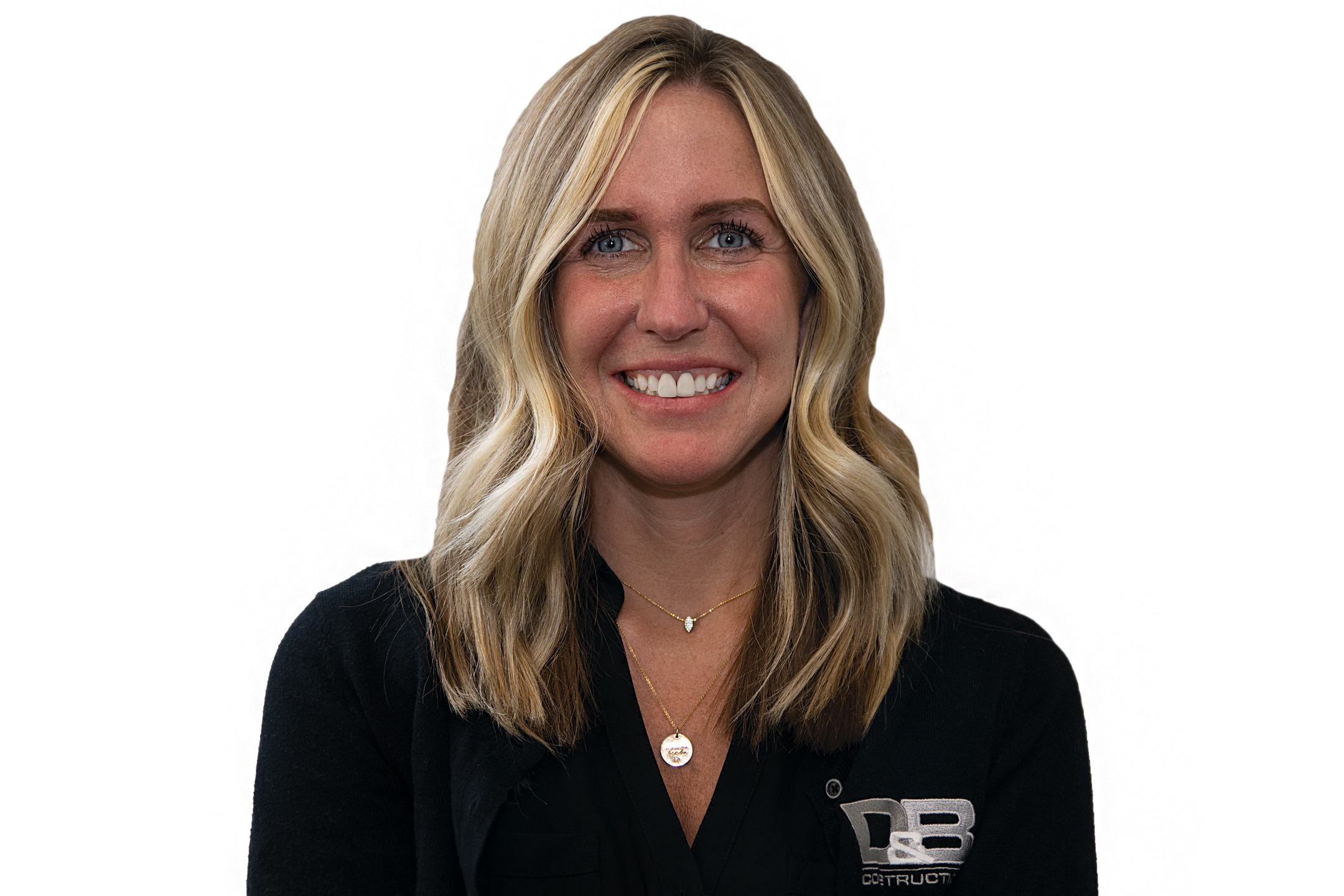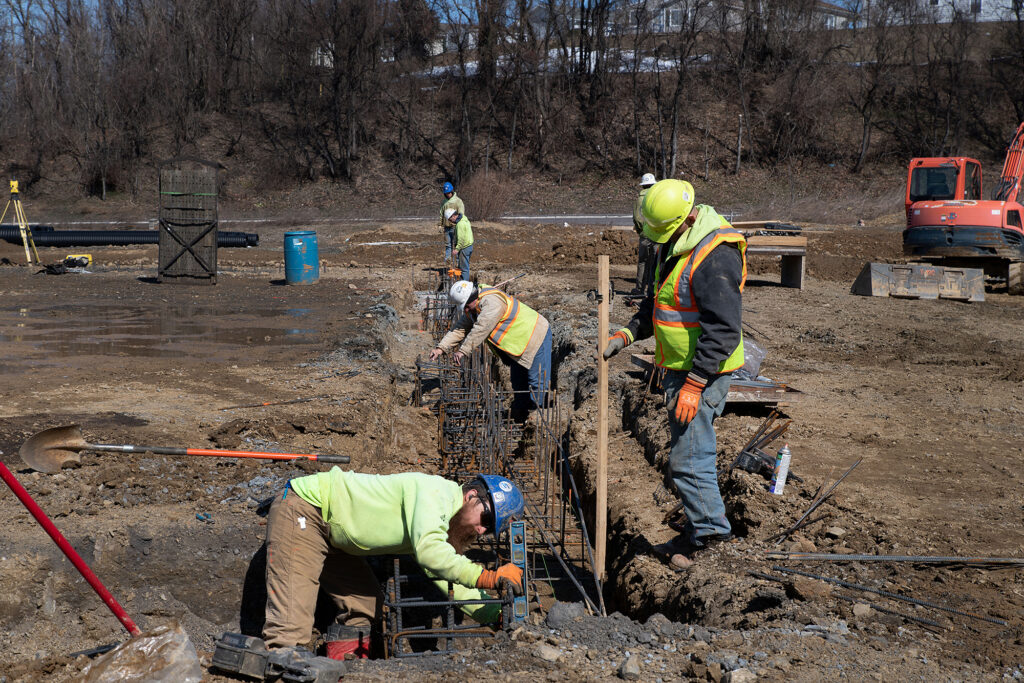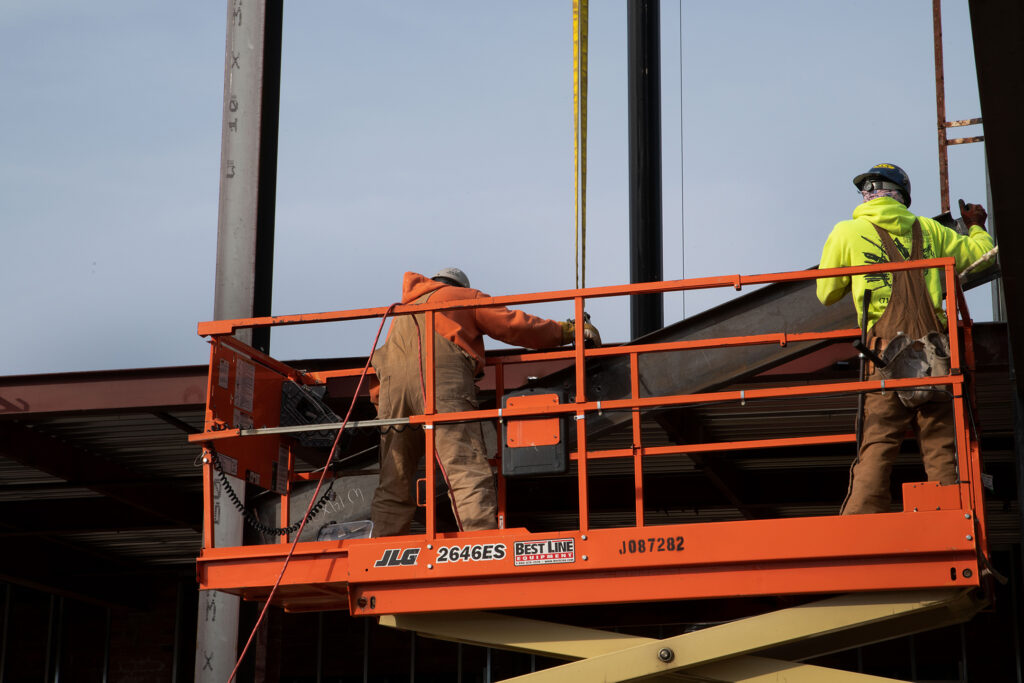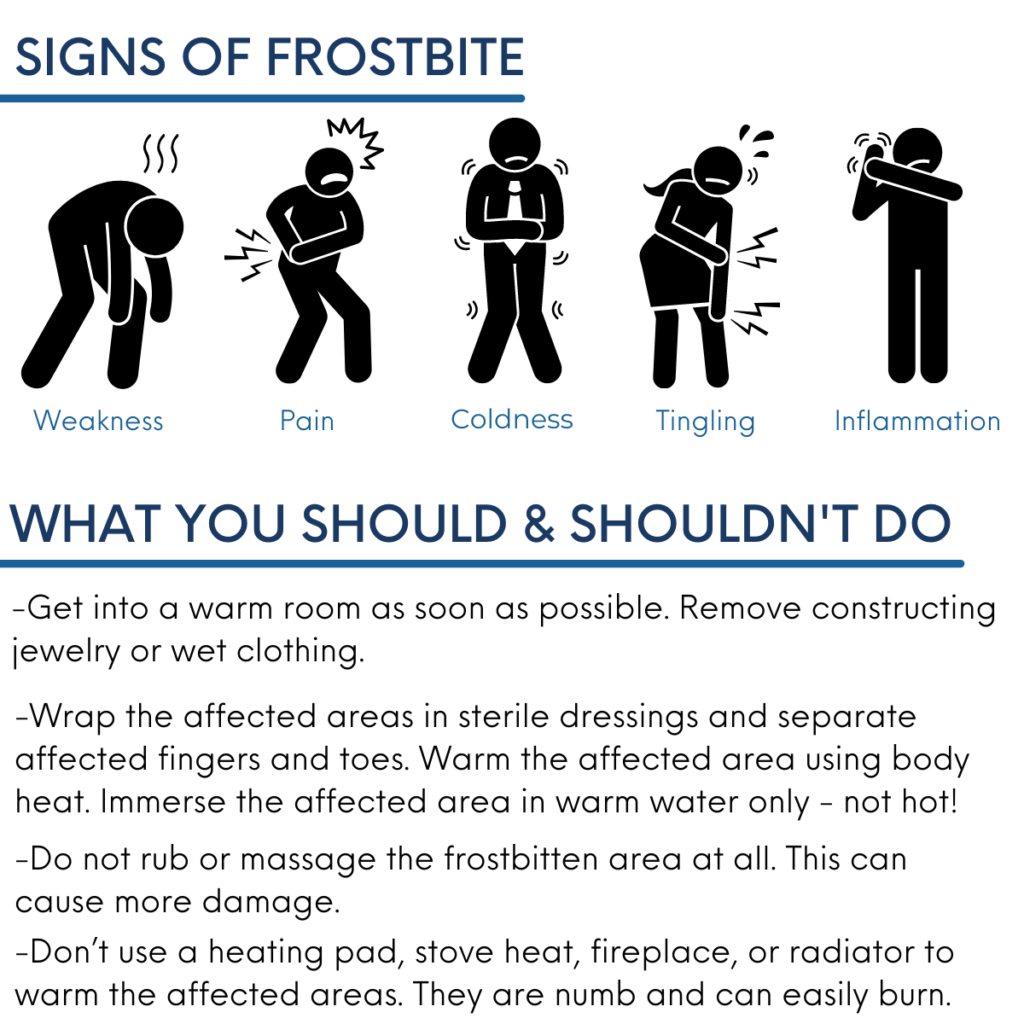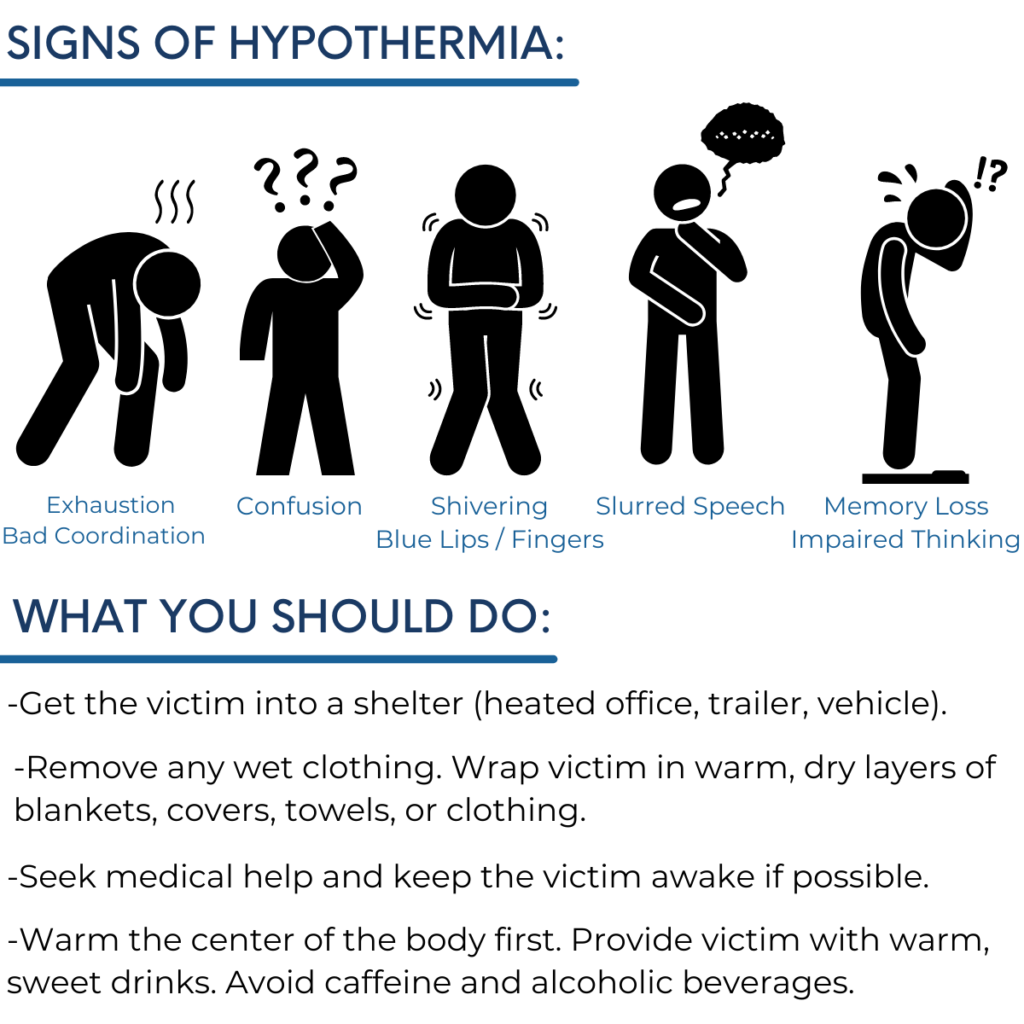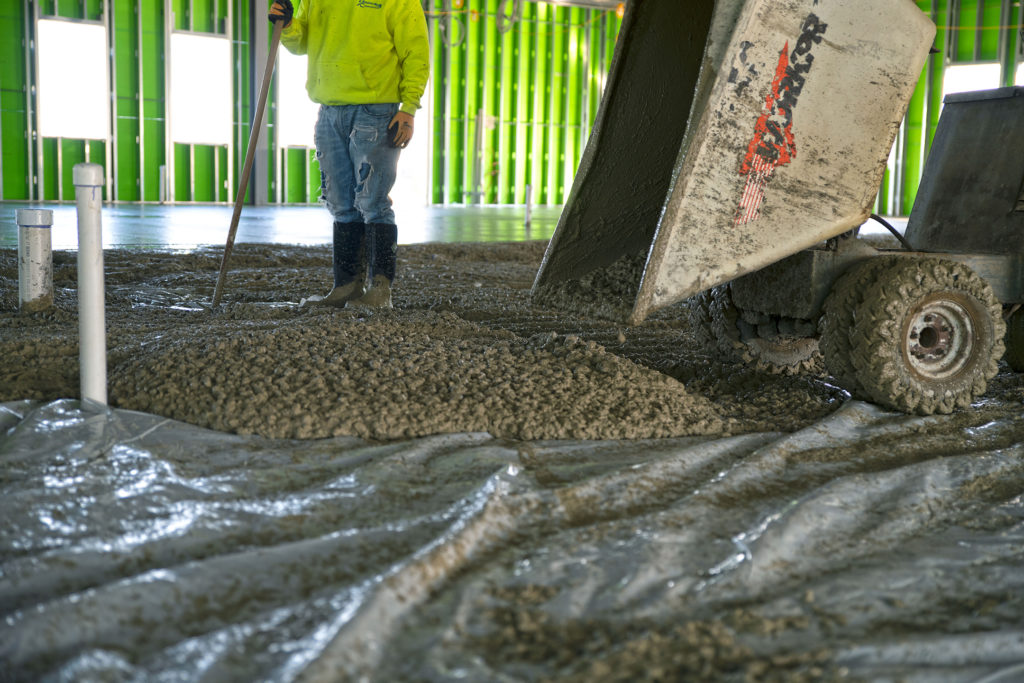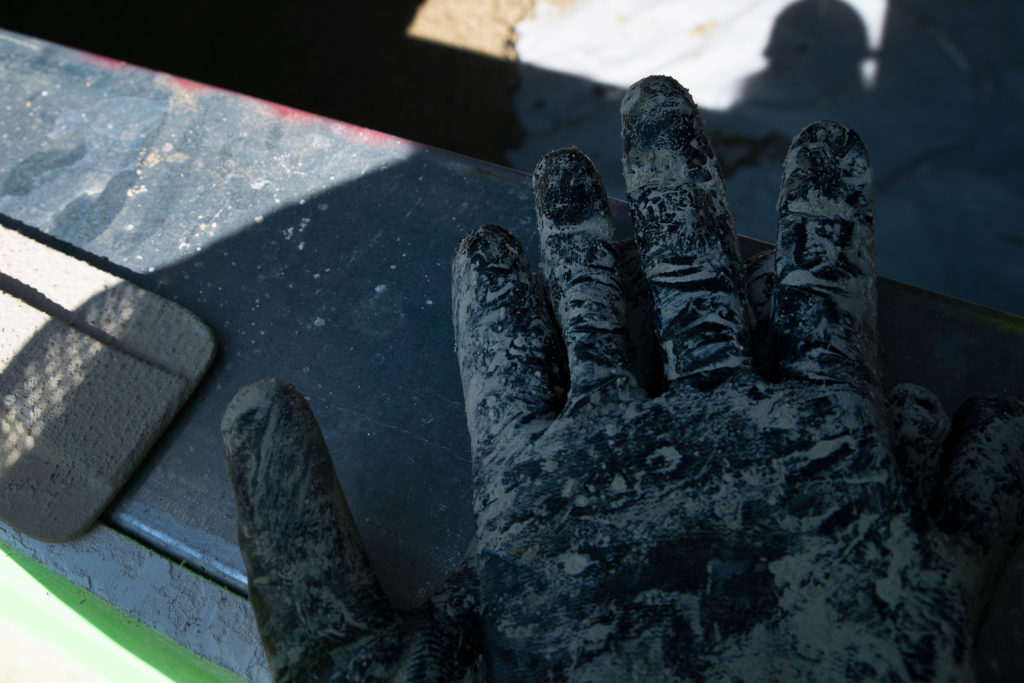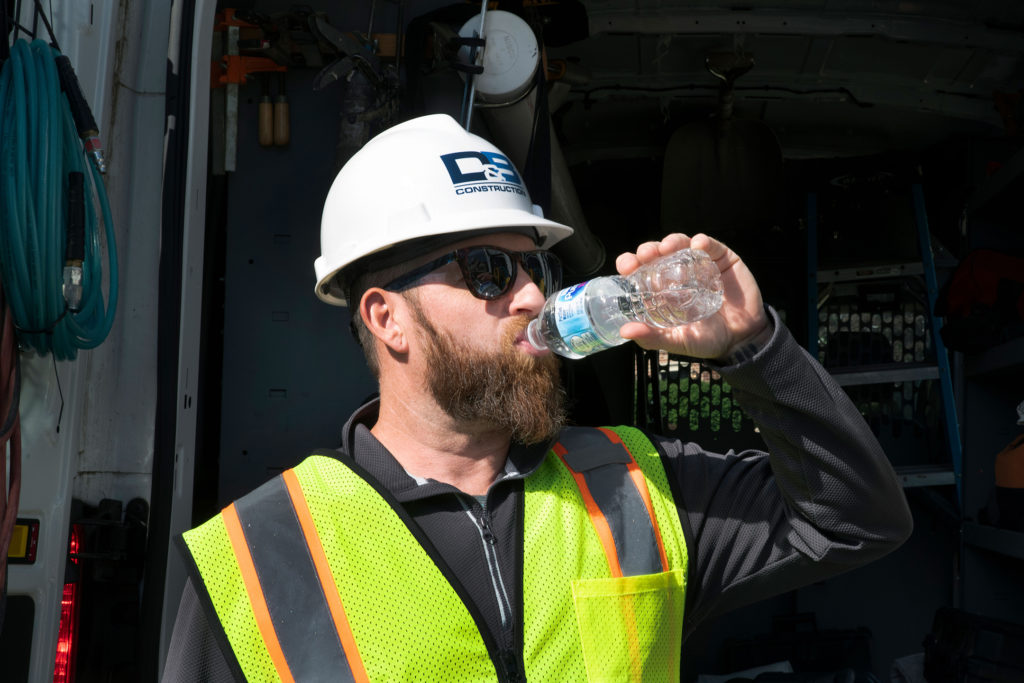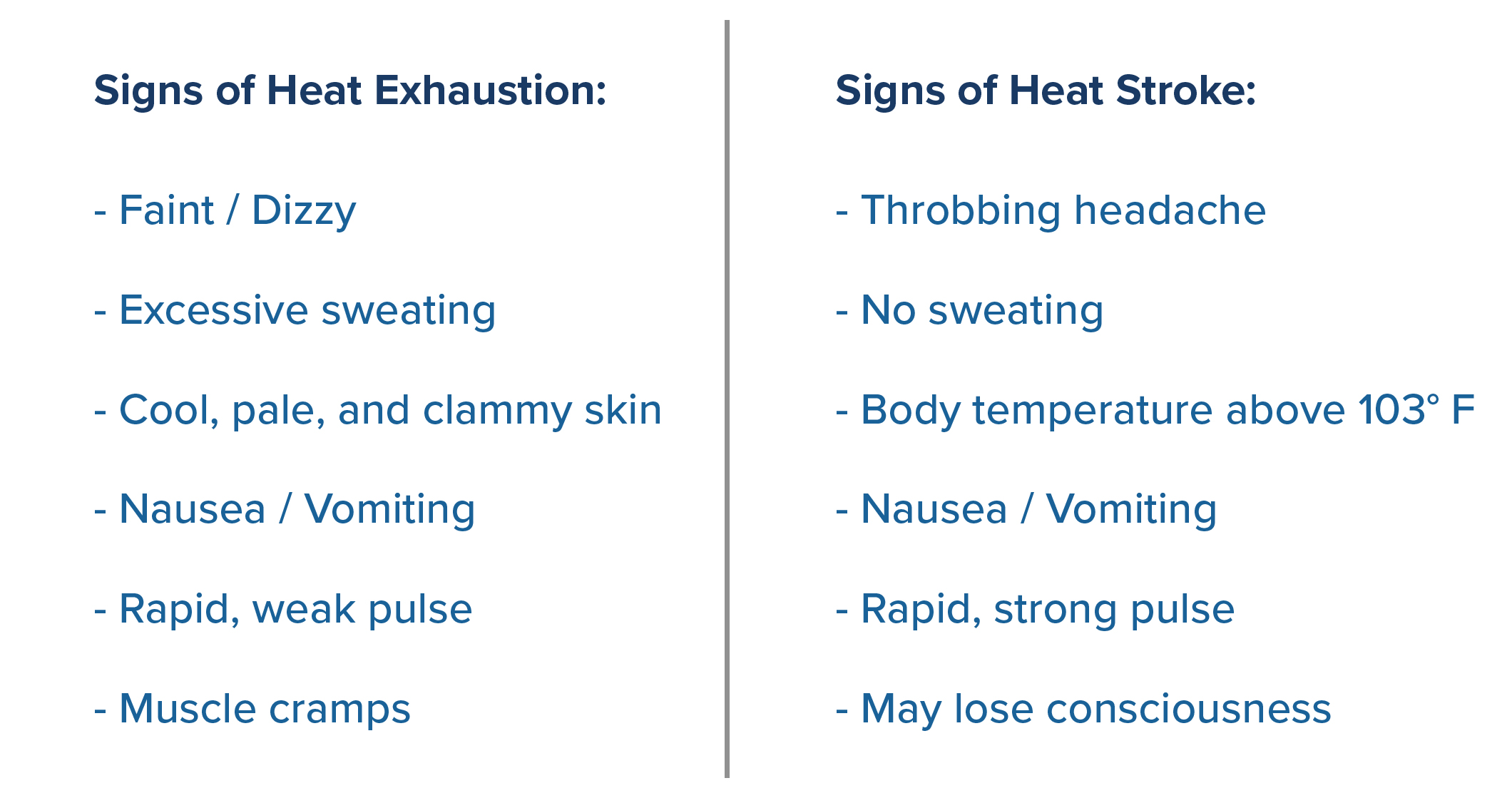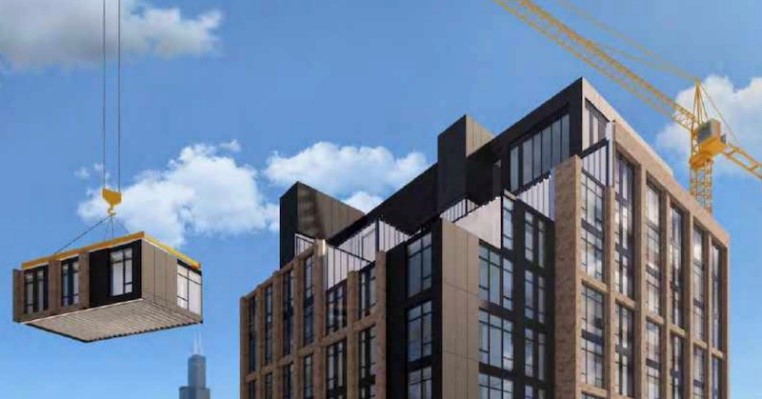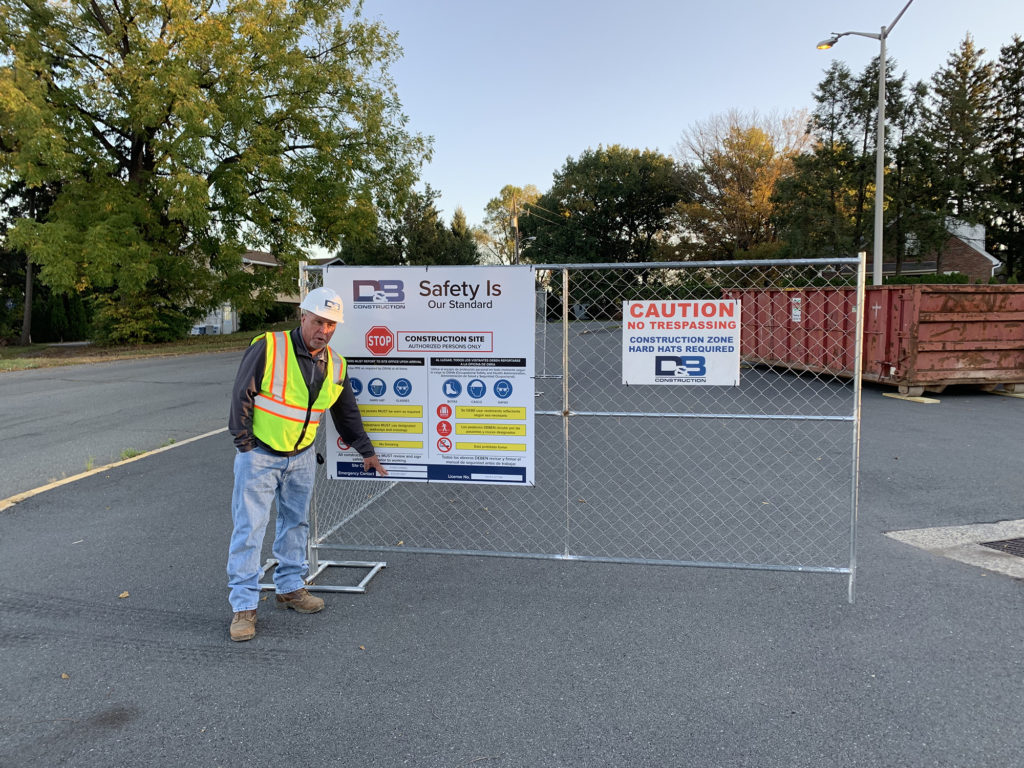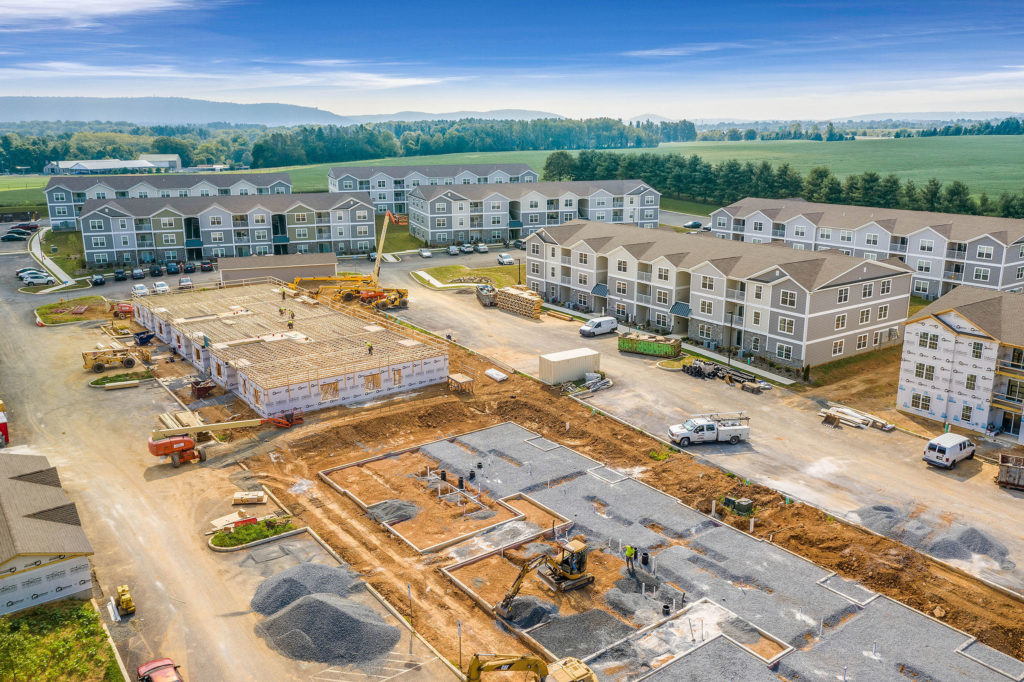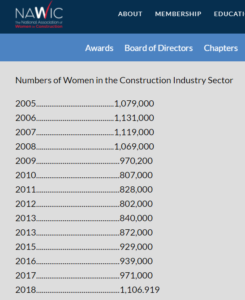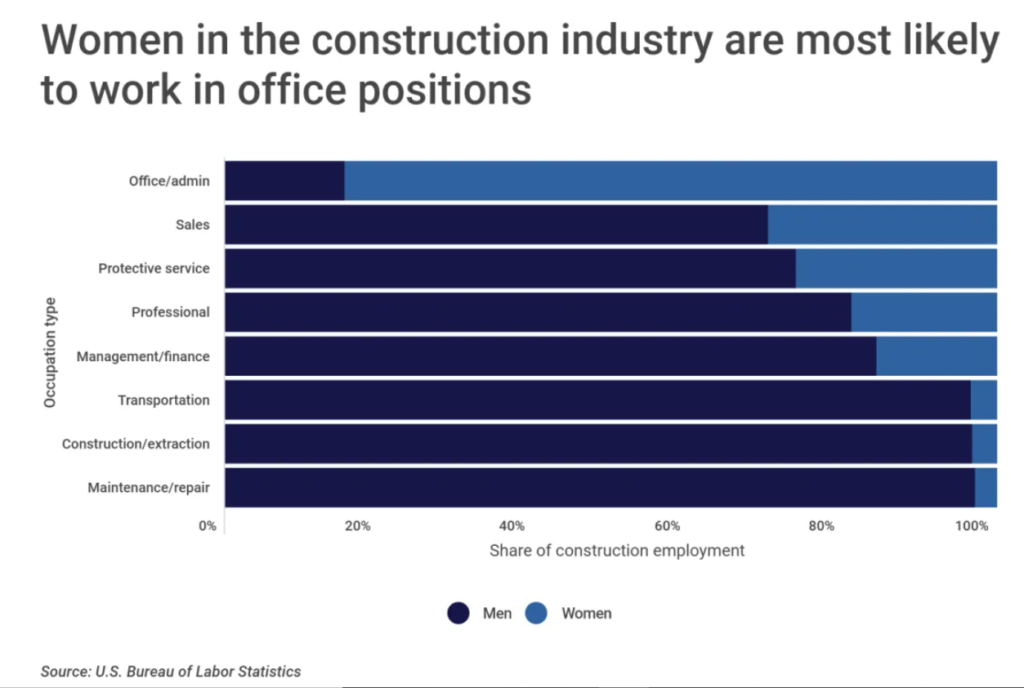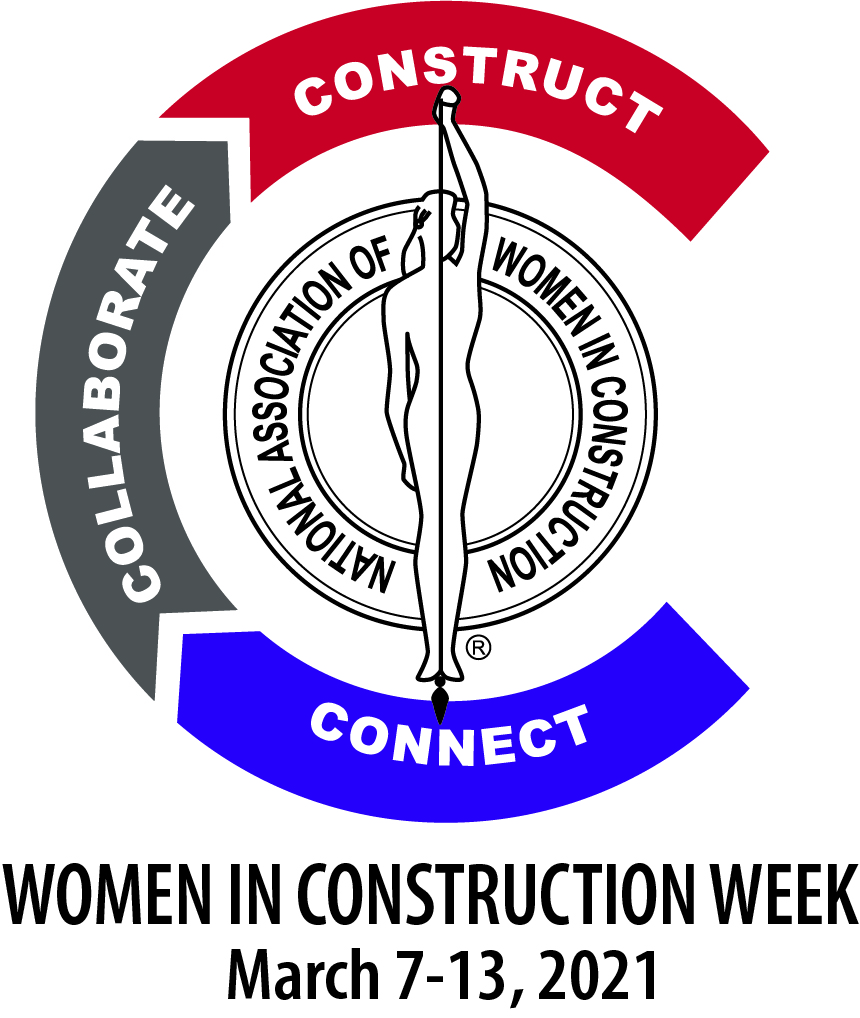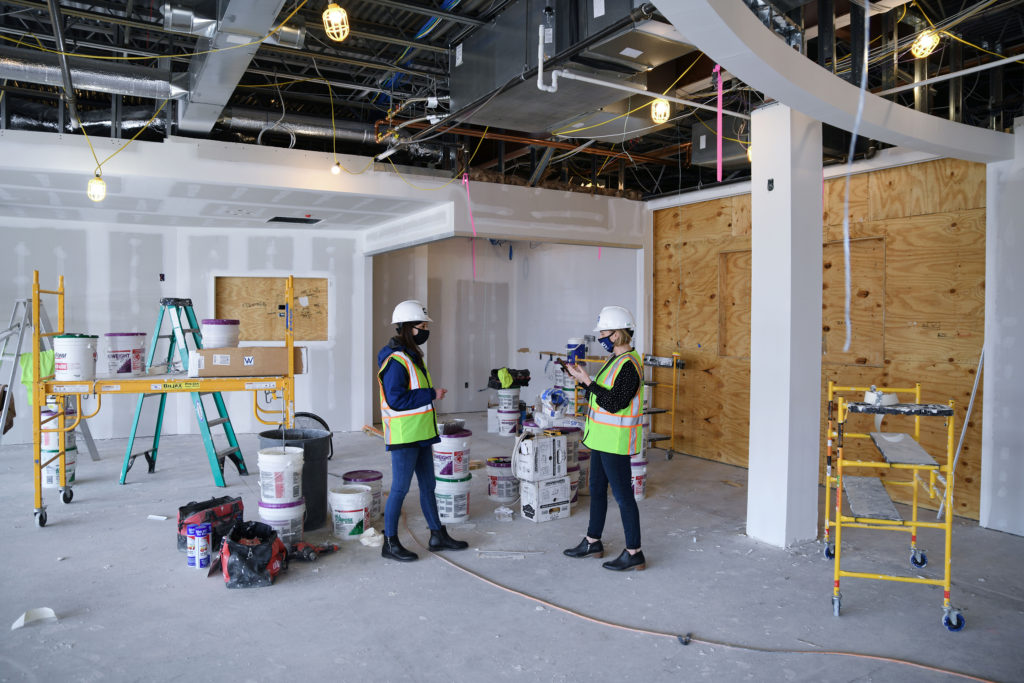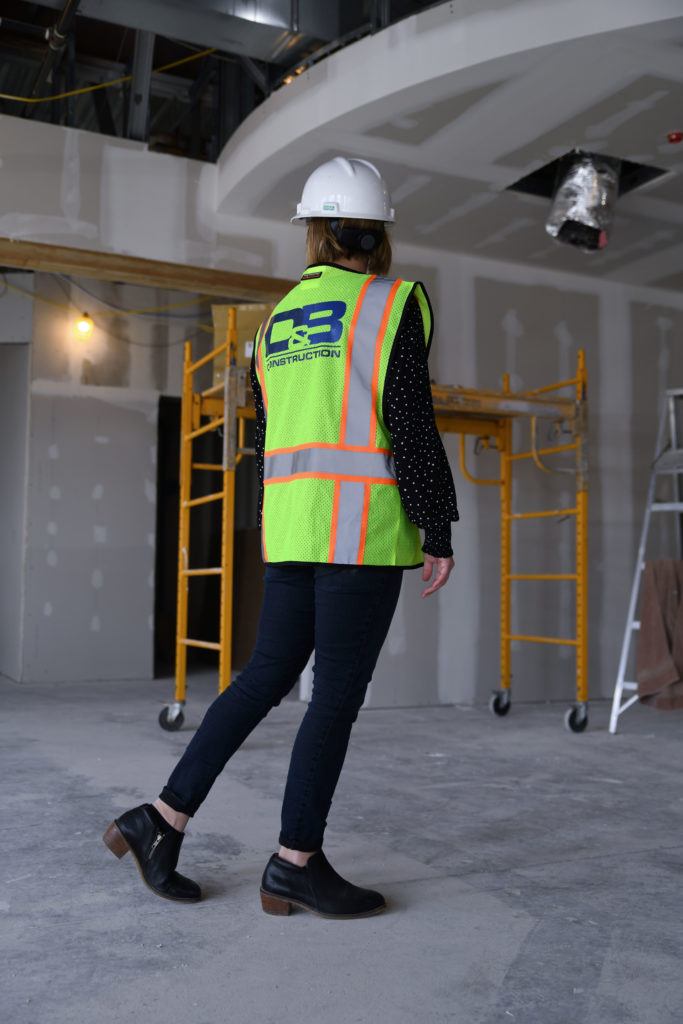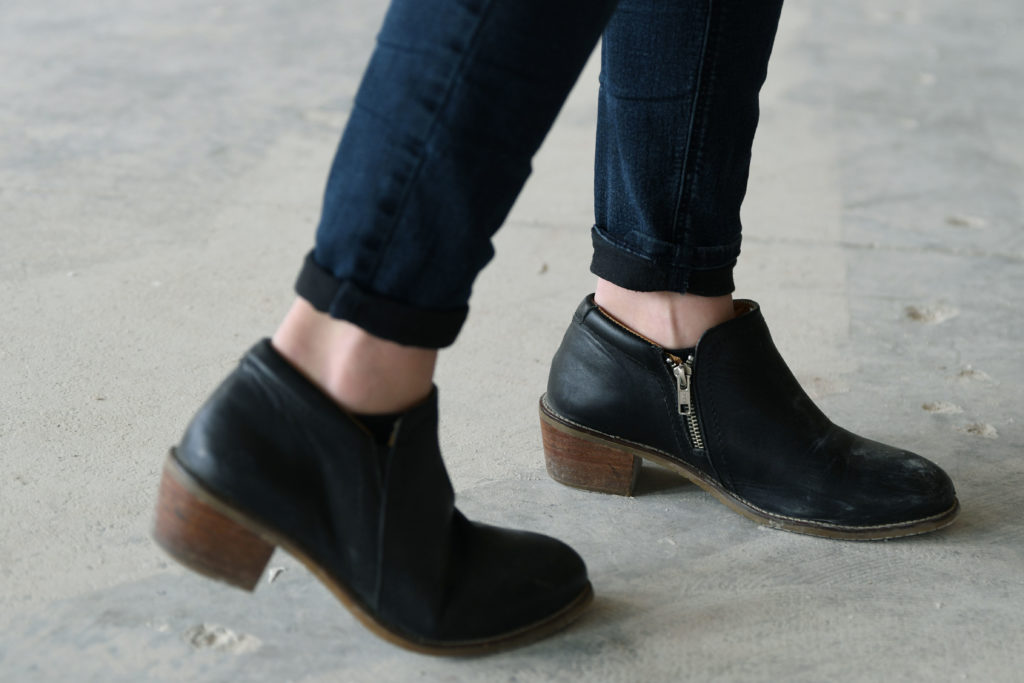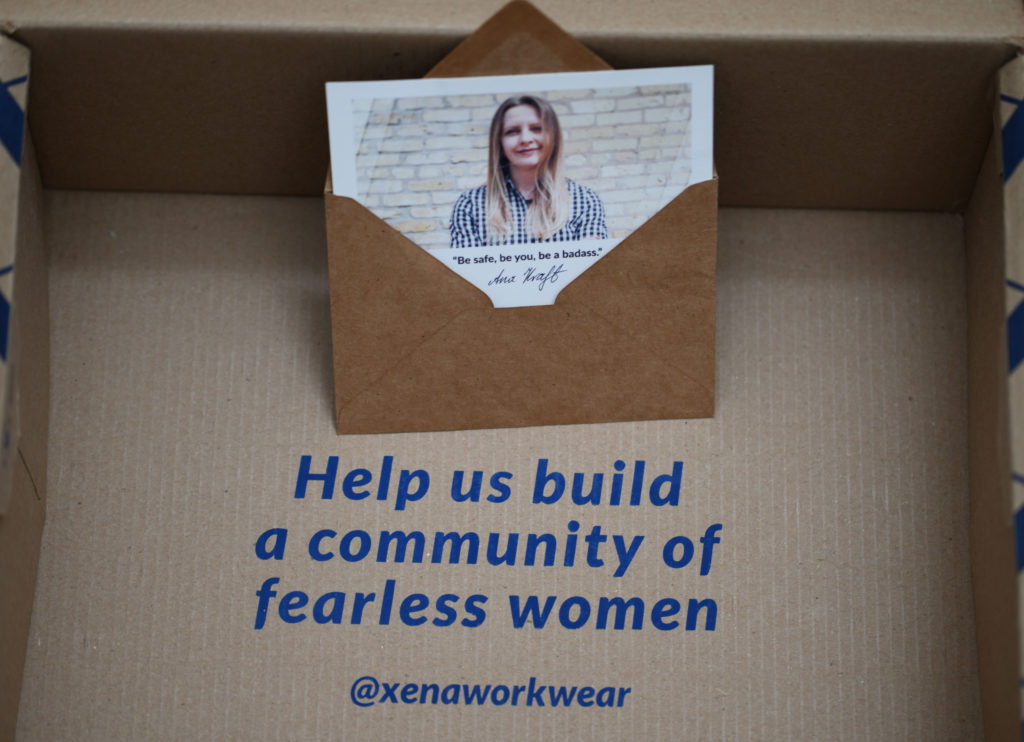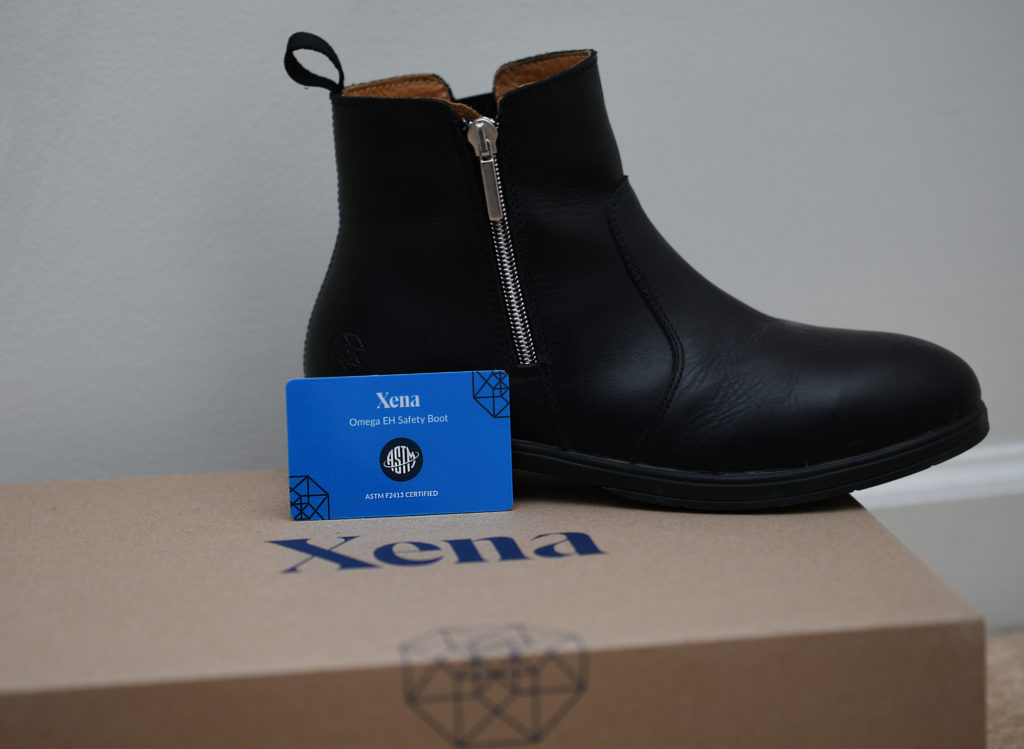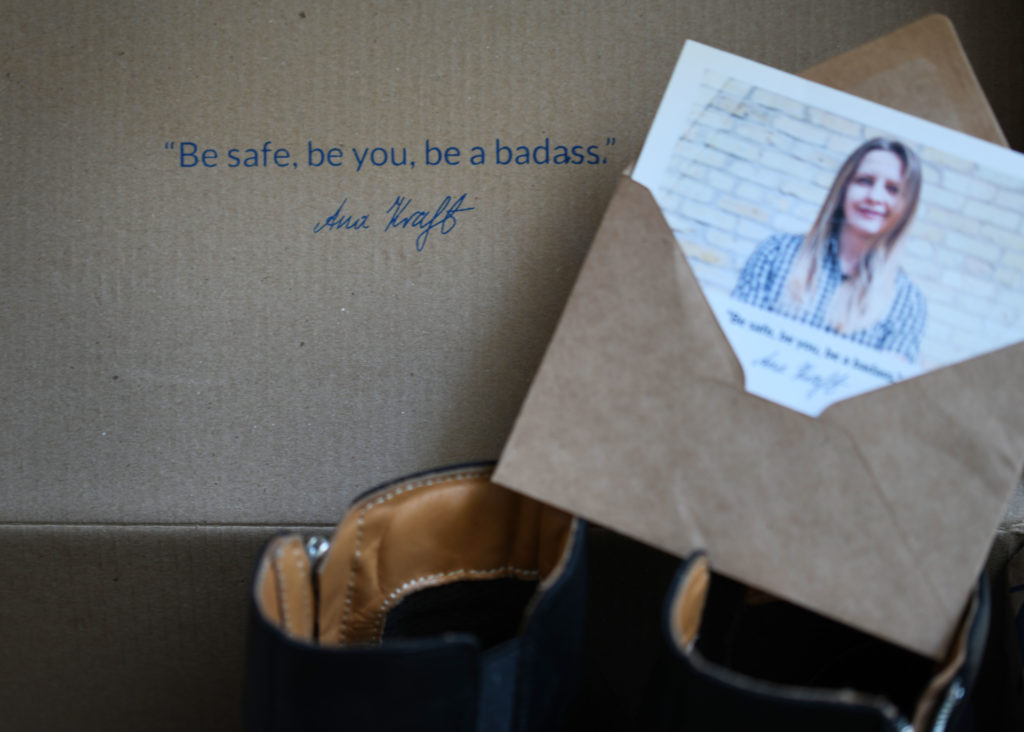“Tenant fit out” is a common phrase you will hear used throughout the industry. It refers to the process of making an interior space ready for occupation. Usually, it is common practice in commercial construction to keep the interior space empty so occupants can create the look and feel of their business while determining the level of refurbishment they need. While an office renovation refers to the work needing done to improve an interior design (think aesthetic revamps such as purchasing new furniture or fresh paint), a fit out involves creating a usable area within an empty space.
The Different Types of Commercial Fit-Outs
A Category A fit out is the standard for what you will find in commercial space ready for renting, with utilities such as plumbing fixtures and electrical wiring already in place. Typically, features like electrical outlets, HVAC systems, fire protection systems, raised access floors and toilets would need to be installed yet.
On the other hand, a Category B fit out requires installing features that are lacking in a Category A. In sum, this fit out focuses on making the aesthetic design specific to the business. It typically involves installing lighting, flooring, painting, partitioning, window treatments, furniture, and branding to make the office yours.
A core and shell fit out refers to a space that already has the framework of the building in place and is ready to be custom fit to its specifications. These fit outs typically include the following tasks:
-Floor installation
-Partition walls
-Ceilings
-Power and Lighting
-Painting
-Furnishings and fixtures (such as casework and millwork)
-Changes or updates that may be needed for structural elements of the space, such as the placement of windows and doors
-Updates that may be needed to HVAC (such as extending into other spaces with ductwork and controls), Electric, Sprinkler systems, etc.
-Cabling and wiring for internet connectivity and communication arrangements (fire alarms and other protection systems)
What to Consider When Contemplating an Office Fit-Out for Your Business:
Fitting out an office space for your organization is a big undertaking that – when done correctly – can have a lasting impact for many years to come. It all starts in the pre-construction phase, where the proper planning and design of your space will ensure a smooth project throughout the duration of construction. Here are a few things to consider:
-An office fit out is an organization’s opportunity to take a blank canvas and make it their own. Consider how you can organize your space to increase workflow and enhance your staff’s performance. Do this by evaluating how the workspace will be used and all that needs to be in it for your team to efficiently complete their jobs.
-Plan for the future. If you ask yourself questions like “How will my business / industry grow and change over the next few years?” and “Will the proposed space be able to accommodate expansion in the future?” you can avoid needing to make renovations sooner than you’d like. As a result, your organization will save money by avoiding having to interrupt business to make changes to your office space.
-Make flexibility top of mind. Consider how technology advances and new trends may impact your office’s workflow. Does your space have the flexibility to adapt to such rapid change?
The Right General Contractor Makes all the Difference:
Most importantly, make sure the people you surround yourself with during this process are reliable, organized, and great communicators. A good General Contractor will help you navigate all of the points listed above.
D&B Construction Superintendent, Joseph, is no stranger to Tenant Improvements, regularly completing fit-outs for our clients like Cardiology Consultants of Philadelphia. He shares some tips on what to look for in the right GC for the job:
-Your GC should provide a dedicated project team to oversee your fit out. In order to make sure the job runs as smoothly and efficiently as possible, your GC should lead the project team in meticulously going over your project’s logistics and specifications in pre-construction. This may include working with your property management team, building architects and engineers, and other tenants in your building.
-Look for a conscientious GC who is actively working out and updating schedule details to limit any type of disruption or inconvenience to your current operations. A constant open line of communication and attention to detail ensures your project is completed on time.
-Weekly client meetings organized by the contractor of your fit out are a good way to ensure you are always fully aware of your project’s progress. Regular touch bases also enable the team to target any changes that you may want to make during the course of construction.
-A good GC will have a well-established relationship and open line of communication with their subcontractors. At D&B, our team works hand in hand with our trade partners to achieve perfection on your project. Our high standard of cleanliness, safety, and quality of work shows through the duration of the project.
“The bottom line comes down to this,” explains Joe: “When the project is completed the client should feel like we exceeded their expectations of the finished product. Starting with the pre-construction team and ending with the final cleaning of the project, we take extreme pride in the work we deliver, as well as the relationships formed with our clients. This makes all the difference.”
A transitional photo showing the before and after shots throughout one of our many medical office fit outs
for our client, Bucks County Orthopedic Specialists.
The old perception that construction is a “man’s job” is outdated, and there’s no better time to shed a light on why that is than during Women in Construction week. You’ll find women leading multi-million-dollar job sites and overseeing operations for construction companies across the country. With supportive employers, they’re also building a more inclusive industry.
What is Women in Construction Week?
Women in Construction Week always takes place during the first full week in March. The purpose of this week is to highlight the many great initiatives and work of women within the industry, while also illustrating all of the opportunities available to women in construction.
The history of Women in Construction Week is allied with the National Association of Women in Construction, which was founded in 1953 by 16 women working in the construction industry in Fort Worth, Texas. In 1960, just seven years after being founded, Women in Construction Week was introduced in honor of the association. The National Association of Women in Construction was initially created to “support the few women working in construction at the time.” The organization has since “gone on to ease the passage of women into construction, helping to create awareness and better working space for those who desire to work in the industry.”
Today, you will find 118 NAWIC chapters across the United states, all providing professional development, education, networking, leadership training and public service. We owe many victories in the industry to the 16 courageous women who started this foundation nearly 70 years ago. Some examples include the fact that the overall stigma of women working in the industry has reduced tremendously, and the pay gap between men and women is relatively small when compared to other industries.
Resources For Women In The Industry:
To learn more about resources for women in the industry check out our Women in Construction Week blog post from last year here on our website. We always like to refer people to the two nationally recognized groups that provide networking and mentorship opportunities for women in the industry: Women Construction Owners & Executives (WCOE) and the National Association of Women in Construction (NAWIC).
We also happen to love NAWIC’s official podcast, Build. Lead. Succeed., which you can listen to here! The newest episode features an interview with Laura Jones, Project Manager with WW Gay Mechanical Constructors, and discusses what it takes to be able to accomplish maximum career growth while raising children.
Another vital resource? Giving our women in construction access to mentors! LeadHeralliance.com is on a mission to do just that. This program offers monthly sessions, workshops, meet ups and networking opportunities, and was created by women for women. By joining as a mentee, ladies will belong to a network of women in the construction trades. They can be “matched” with their own professional personal female Mentor, who will help grow their career. The group is also always looking for mentors to help recruit, retain and support females new to the construction trades. Feel free to connect with Sarah Hilton, Director of Programs, to learn more!
How Women Help Grow The Industry:
Research has shown that organizations with above-average diversity had 19% greater innovation revenues. There is a clear positive relationship between innovation and diversity, as depicted by The Boston Consulting Group’s survey on diversity, which spanned across 1,800 companies in eight different countries.
If you are alive in today’s world, chances are you aware of the workforce shortage issue. According to the Bureau of Labor Statistics, approximately 400,000 new jobs will be added to the construction industry from 2020 to 2030. One solution to this growing problem is recruiting women, who make up 47% of the total workforce. It is not only smart – but necessary – to employ, educate, and support women construction workers. Doing so helps ensure long-term industry progress.
Another report by McKinsey & Company revealed that gender-diverse companies are 25% more likely to achieve above-average profitability than companies with less diversity in their Diversity Wins report from May 2020. One highlight in particular that stands out from this report? When women filled 30% or more executive-level positions in a company, the companies were 48% more likely to outperform their least-diverse competitors.
A study by the National Bureau of Economic Research revealed that women are more likely to collaborate than men, a trait highly sought out in construction management since there is no doubt that construction projects require a high level of collaboration. The increase in teamwork and cooperation that women bring to the table can lead to significant improvement in a company’s productivity and profits.
Women’s ability to be great listeners and communicators and to pay attention to tasks that require precision for longer periods of time make them valuable employees on the job site, too, where tasks such as framing require great accuracy.
Overall, adding a woman’s perspective to a male-dominated world can bring a new approach to how things can get accomplished. Their input is valuable and beneficial, and they can greatly help to improve interpersonal relationships.
Despite the many advantages that women bring to the table, only 7% of architects and engineers are women, 5% of contractors are women, and 4% of construction managers are women. Below are some reasons as to why this may be given the set backs women have historically had to face:
Pay Gap: Historically, statistics reveal that 43% of organizations don’t actively monitor gender pay gaps. However, this trend has slowly been reversing. The National Association of Women in Construction recently reported that “women earn an average of 99.1% of what their male counterparts make in the field.” It has been reported that women working in construction and trade earn 30% more than those working in women-dominated occupations.
Gender Bias: Women are the victim of 60% of gender discrimination cases in the workplace.
Lack of Advancement: Over 70% of female construction workers have felt passed over for roles because of their gender. Women only make up about 14% of staff executive and 7% of line executive positions. The good news? In 2018, it was reported that nearly one in three companies promoted women to leadership roles and other executive-level positions. According to NAWIC, “a significant percentage (44%) of women currently employed in construction projects work as construction managers and other management professionals.”
Ways To Empower Women In The Industry And Those Looking To Join:
Lead by example. Help the women on your team feel like part of the solution (because they are). Treat all workers equally – with respect and courtesy – at your construction site.
Provide the women in your industry with female mentors or role models within the industry to help them navigate workplace challenges. (Don’t forget to check out com if you are interested in having or being a mentor.) Did You Know: Over 45% of women in construction have never worked with female construction managers?! Reducing this shortage of role models would have a lasting impact.
Offer STEM mentorship. Statistics don’t lie and they show that when it comes to who is graduating with a construction management degree, men still “significantly” outnumber women. Why is this? The answer may come down to the simple point that women may not be presented with construction as a career option the way men are. Conducting outreach for young women interested in exploring the field is crucial. STEMblazers does this by inspiring girls to visualize themselves in science, technology, engineering, and math professions. They have a long term goal to reach 1 million girls and influence them to pursue a career in STEM so women can be equally represented in the STEM workforce.
Meet The D&B Ladies:
Last year you met Lesley, Jess, Beth and Angela as we celebrated WIC week. In a year’s time the ladies of D&B have since doubled. (Woohoo!) Meet Bryn Heist, RA (Project Manager), Rachel Hope (Office Coordinator), Melany Eltz (Commercial Project Coordinator) and Kellie Mackie (Estimator and Assistant Project Manager) for our sister residential company, D&B Elite Custom:
Meet Bryn, RA – Commercial Project Manager:
Bryn is a seasoned Design and Construction Project Manager and Architect. She joined Team D&B with nearly 40 years of industry experience. Bryn first joined the industry as an Architect serving clients before making the transition to Owner’s Rep, which allowed her to coordinate between the Design Team and Contractors. She is excited to continue to serve clients through her role as a member of the Contractor’s team with D&B Construction. Bryn’s career experience spans across an array of sectors including healthcare, commercial, institutional, industrial and residential construction. She has spent the last 20 years of her career with a focus in the healthcare industry as Senior Project Manager for Universal Health Services (UHS) and Project Manager for Tower Health Systems (Reading Health Systems). Throughout this time, Bryn effectively managed multiple projects ranging from $100K to $52M concurrently. She enjoys being involved at the inception of a project and seeing it through from construction to occupancy. Bryn appreciates the problem-solving aspect of design and construction, particularly the collaborative team efforts required to produce the end result of the process – an occupied building which fulfills the Client’s needs and exceeds expectations.
Q: What has been the most memorable moment in your construction career and why?
A: “Being the Sr. PM for the design and construction for a 100 bed 82,200 SF Behavioral Hospital facility which came in under budget and on schedule. The 5-acre site, fall start date in a mid-west region, REIT funding and a JV partnership provided multiple challenges. The Design and CM team were great collaborators and the relationship established and maintained with the City and State made this the success it was. The project provided much needed care for patients across the region, which were otherwise not served. Plus, the building functioned well and was aesthetically pleasing.”
Q: How do women enhance profits for companies and what do they bring to the table?
A: “Diversity in general, not just gender-related, is known to provide different backgrounds, skills and perspectives, all qualities which can enhance the workplace. Companies who are more diverse have a larger pool of applicants which lead to better talent. Diverse teams are known to perform better with improved decision making and new ideas. Increased creativity, skills and productivity impact the bottom line.”
Q: What are the advantages of being a woman in construction?
A: “Construction provides more variety than many other industries where women are often employed. It requires new skill sets, knowledge and experience, all of which creates a richer career.”
Q: What advice would you give to a young woman entering the industry?
A: “Learn as much as you can both in the classroom and in your work experience. Gain as much experience by accepting all reasonable opportunities. Speak up when you have something that can contribute to the team. Ask questions. Don’t be afraid of being in the minority. Listen and continue to learn.”
Q: Women make up only 10.9% of all workers at a construction site in the U.S. What makes you proud to be a woman working in the construction industry?
A: “Gaining respect from men who may not have worked with women up to that point after proving you are capable of the job and add value to the team. Leading the way for other women.”
Q: Has there ever been a time throughout your career in the industry where you felt you weren’t taken as seriously due to your gender / any specific stories you would like to share?
A: “There are always men who cannot accept a woman on equal ground. Just do your job the best you can and ignore what you can’t change.”
Q: Have you ever felt bothered that there aren’t more women in construction? Why / why not?
A: “No, I have not felt bothered because I’ve been in the design/construction industry for 40 years and see the great strides that have been made and continue to improve for women in all industries. The fact that you can purchase decent looking work boots says it all.”
Q: Do you feel you see more women in the field compared to when you first started working in construction?
A: “Twenty years ago, I was almost blatantly rejected as a hospital PM because of my gender. I was eventually hired for that position. Now the same company wouldn’t even consider that to be an issue. So yes.”
Meet Melany – Commercial Project Coordinator:
Melany is a testament to the fact that having a female mentor and role model can play a big roll in fulfilling a career in the industry. Melany’s mother has worked in the furniture manufacturing and cabinet industry for over 20 years, with 18 years in retail prior to that. She has a wealth of knowledge when it comes to retail stores, office fixtures, and residential spaces.
“I started helping my mom with computer data entry of client sales orders at the young age of 12. This allowed me to become familiar with what a manufactured piece of furniture was and how demands needed to be met. During and after college her business was looking for interns, so I was excited to be part of the company on a new level. Working with my mother for six years taught me how to talk to clients and co-workers to get positive results. She taught me that using kindness, patience, listening to others, never saying you could not help, and setting an example for her team equals respect and admiration. My mother works hard, delegates when needed, and manages people in a friendly way. As a result, people love working hard for her to get the job done on time, and she has a great client following from providing service in excellence.”
What advice would you give to young women entering the industry?
“Have confidence in yourself, know you worth, and know that a woman is the best man for the job.”
What do women bring to the table for their companies and the industry as a whole?
“I believe that women are creative, innovative and are not as rigid / ‘black and white’ as men. It’s the grey area that women seem to be able to think more outside the box and can maybe find more creative ways of making money or profits. Women bring sensitivity and compassion to the table, along with being well organized and having that overall drive to always do a job well to make clients and coworkers happy.”
Women make up only 10.9% of all workers at a construction site in the U.S. What makes Melany proud to be a woman working in the construction industry?
“The ability to excel in a ‘man’s world’ as a woman is exciting and rewarding.”
What do you think is the most important change currently happening in the construction industry and why?
“With the issues and challenges in this world today with material shortages, rising costs and delivery delays, the ability to focus on the big picture, exude patience and understanding and have the ability to reason with clients and co-workers is truly a must have.”
Meet Rachel – Office Coordinator:
Rachel joined Team D&B with 15 years of experience as an Optical Manager for an eye care office. Although she never worked in construction before joining our team nearly a year ago now, she can attest to the “big impact that having a strong woman leader in the work place has.” In the last year since she joined Team D&B, Rachel has “learned how to be strong, prioritize workloads on projects, the construction ‘lingo”, and the huge impact that safety has in the industry.” She is excited to continue to keep learning and growing in construction and is “pleasantly happy to see how many women have been working in this industry for a long time.”
What do women bring to the table for their companies and the industry as a whole?
“In doing some research, women have outscored men in their ability to take initiative and drive for results. Women have empathy, are mindful, can multitask and have open communication – all which are great traits and make teams more in sync.”
What do the women of D&B bring to the table for our clients, trade partners, and co-workers?
“The women of D&B build solid workplace relationships.”
What are the advantages of employing women in construction?
“Women can introduce new methods or approaches that have not yet been explored.”
What are some ways that male leaders within the industry can empower their female colleagues?
“Be sure women’s voices are heard (in meetings, especially), practice transparency, and listening.”
Meet Kellie – Residential Estimator / Assistant Project Manager:
Kellie joined our residential construction company, D&B Elite Custom, in September of 2021. Prior to starting her career with D&B, she worked at Griffiths Construction for nearly four years as a Project Estimator.
What has been the most memorable moment in your construction career and why?
“I have had many experiences in my career but most memorable would be the final walk through with a woman who was planning on moving her aging mother and handicapped brother into an ADA addition we completed at her house. To see the satisfaction in knowing she now could care for her mother and brother in a safe and comfortable setting right at her home was priceless.”
What do the women of D&B bring to the table for our clients, trade partners, and co-workers?
“In my experience women in construction bring just as much to the table as our counterparts! My experience values me, not my gender. I love the diversity our company brings to our clients. The gender stereotypical roles of the past are breaking down and we are seeing more females take the lead in designing, coordinating and actually performing the field work. This can only set the stage for future growth as D&B stands out among our competitors.”
What are some ways that male leaders within the industry can empower their female colleagues?
“Without the forward thinking of men in the construction field, women would not be able to achieve what we have to date. Since most of the construction field is male dominated, it takes a smart man to see past a woman’s gender and look at them for their experience and not their gender. I am thankful for the men at D&B who have succeeded in achieving this mind set and evaluate each individual on their skill sets and experience rather than gender.”
Insight From Our Executives:
In order to encourage more women to join the industry and lift up those already working in construction, it is important to have everyone amplifying the voices of women in construction. Dan Gring, Chief Executive Officer of D&B Construction and Drew Bell, Vice President of Business Development, offer insight on how male leaders within the industry can empower their female colleagues, how the industry as a whole can work to attract more female candidates, and more in their Q&A below:
The number of women that make up D&B’s growing team has doubled (from 4 to 8 women) just since last year’s Women in Construction week. How can the industry as a whole work to attract more female candidates?
DG: “Focus on women’s overall work experience versus just focusing on specific construction experience. There are so many industries that cross-over construction (Engineering, Design, Sales, etc). It is important to look at overall success versus simply construction background. Without changing to this broader thinking, we’ll be missing many well-qualified female candidates.”
DB: “I think the heavy influence of men in construction comes from trade schools. Boys/young men get pushed into the trades as a career much more than women. I think the construction industry as a whole should emphasize that working in the trades is an honorable, noble and lucrative career path for women as well.”
What do the women of D&B bring to the table internally for our D&B family?
DG: The experience, knowledge, and commitment our women bring to our overall team is extraordinary. Our women bring a great emphasis on culture and are committed to a true team atmosphere. The attention to detail to their day to day helps D&B keep on track to our mission and goals.”
DB: “A different and valuable perspective. It’s no secret that men and women’s brains have variations to digesting and using information. Our women in construction bring a can-do/get-it-done attitude that is a great asset. They also have a knack for details which is instrumental to keeping everyone on task and fully completing objectives.”
What do the women of D&B bring to the table externally for our clients, trade partners, and suppliers?
DG: “Communication is the most important thing when interacting with our clients, trade partners, and suppliers. Our female colleagues at D&B are some of our best communicators, and our clients and partners recognize this.”
DB: “Everything. Most importantly could be relatability. Many of our projects are for companies that are run and/or owned by women. The ladies of D&B help teach men on our team the best way for conveying information and asking the right types of questions to make sure everyone is on the same page.”
Why is equality in the workplace important? How does D&B work to shorten the gap of inequality?
DG: “D&B recognizes the need for equality in the workplace. It creates more positive and productive working relationships, creates brand reputation, and it attracts the best talent. D&B is working hard through recruiting and an overall brand to represent ourselves as a place where all people want to work.”
DB: “Equality is the best method to create the most cohesive office environment. Everyone’s input and experience are invaluable in making essential business decisions. It’s essential to secure a good balance of influence from men and women in every facet of life, particularly work.”
A report by McKinsey & Company revealed that gender-diverse companies are 25% more likely to achieve above-average profitability than companies with less diversity in their Diversity Wins report from May 2020. Why do you think this is? In your opinion, how do women enhance profits for companies?
DG: “By having a gender-diverse company you create those relationships with clients and business partners that help bolster reputation and sales. We believe gender-diverse companies help to increase creativity within the organization that sets you apart from the competition.”
DB: “It comes down to perspective. Everyone thinks differently. Diversity in ethnicity and gender is critical for having collective decision making. Women, from my experience are great at critical thinking. This plays a significant role in strategic planning and day to day project management.”
What are some ways that male leaders within the industry can empower their female colleagues?
DG: “Male leaders can empower their female colleagues to continue to give their thoughts and opinions as their message is powerful and creative compared to the ‘standard perspective’ of our construction industry.”
DB: “Listen, include and value. I feel it’s common for people to be dismissive of input from people who are perceived to be less skilled/experienced. It’s changing the perception that is key. Men should not be dismissive of a woman in construction because she didn’t cut her teeth by swinging a hammer or hanging drywall. Our female colleagues have learned from experiences throughout their own construction journey that has educated and solidified their understanding of our job’s demands.”
Cold weather is upon us as we gear up for another Winter season. It is crucial that all workers in the industry are prepared to work in these cold weather conditions. We prepared Team D&B for the cold months ahead at the start of December during our monthly Safety Meeting. Our Superintendent, Jason, presented a Tool Box Talk on Cold Weather Considerations. Since safety is our standard we wanted to share some of the pointers our team discussed during our latest Safety Meeting:
-Wearing several layers of clothing is always more beneficial than wearing one thick layer when working in cold weather.
-Did you know that forty percent of a person’s body heat can be lost from an uncovered head?! Because of this, wearing a warm wool hat or a helmet liner under your hard hat is always a good idea. Be sure to cover your ears and remember to wear gloves, too!
-When it comes to footwear, wear one or two pairs of warm socks. Your footwear should not fit too tightly or it will restrict blood flow and ultimately cause more harm than good.
-In cold, windy weather it is a good idea to wear a face mask or scarf.
-You need energy to keep your muscles warm, making it important to avoid exhaustion and fatigue. Take frequent short breaks in a warm shelter so your body has time to warm up and relax.
-Drink warm, sweet beverages and avoid drinks with caffeine. Eat warm, high calorie food such as pasta dishes for lunch.
Tom Rinaldo, our Safety Director and Vice President of Construction for Reading and Central PA, also provided us with some helpful insight to common questions people tend to have regarding cold weather safety:
Q: What are some ways you keep warm when working outside in the cold?
A: “Proper attire during the cold weather months is a definite must. You definitely want to have proper socks and footwear. Keeping perspiration away from the skin is a big one. You want socks that wick sweat and perspiration. Wearing synthetic or cotton clothing next to your skin is the best way to wick away any sweat. If you keep that sweat away from your body, you won’t get as cold. The reason people’s feet get cold is from sweating, which happens even in the winter – especially when working on a construction site. The body can lose up to 85% of its heat through sweating during exercise. I recommend purchasing socks that wick the sweat away from your feet to help you stay a lot warmer. There are several different brands available. I believe Under Armour makes them, and Wick Dry CoolMax by Fox River is another go to brand.”
Q: What different kinds of foods do you eat/drink in the winter to keep you warmer?
A: “You always need to stay hydrated. People don’t realize this, but even though it is Winter you still need to drink plenty of water to stay hydrated. You will see me with a thermos of hot soup for lunch instead of a cold sandwich in the winter time.”
Q: Do you make sure you go somewhere warm for breaks in the colder weather? If so, where do you suggest?
A: “We usually tell the guys to go into their vehicles if they are out on an open construction site. If they are on an interior construction site there is usually heat on. At our job sites, we also have temporary heaters on. These are not only to keep the worker’s warm, but also for the product we are putting in. Once you get to drywall you have to condition the space.”
Q: What are some clothing layering methods you use?
A: “A very important factor is keeping the wind off you. When you layer your clothing your cutting the wind out from getting to your body. Having the proper gear, such as boots, gloves, and a hat are very important. Last month we got a new order of hats so our Team has them to put under their hard hat when on the job site.”
Tom usually wears three layers under his winter coat: A t-shirt, a long sleeve t-shirt, and a hoodie. He also wears long underwear, wicking Under Armour shirt, and Under Armour bottoms.
Q: What are some ways that a Site Superintendent can help the men and women on their job sites stay warm?
A: “Making sure they have the proper attire and making sure they are taking the proper number of breaks, especially when the temperatures get below 20 degrees. We typically have two 15-minute breaks throughout the day, one in the morning and another in the afternoon, in addition to a lunch break. At D&B, we always educate our team on hypothermia at safety meetings and in our safety training. We know that one of the main injuries, according to OSHA, would be slips and falls. This, along with hypothermia, frostbite, ice, cold stress, and winter colds and flus are common winter hazards that we educate the team on.”
Q: What do you recommend someone new to working in the cold weather prepares for?
A: “It is important that they make sure they have the right clothes. They may not be used to spending eight hours out on a construction site, so it is important that they have the proper gear for the elements.
Q: Are there any common misconceptions that people think are helpful in the cold, but are harmful?
A: “Coffee might warm you up for a few seconds, but since it contains caffeine it can increase your urination frequency and ultimately dehydrate you. Make sure you drink it in moderation to avoid this.”
Q: Anything else you want to add?
A: “You have to know when your body is telling you to get away from the cold environment. Realizing the signs of cold stress, hypothermia, frostbite, etc. are important. Listen to your body. It will tell you when to stop doing what you’re doing.”
Frostbite and Hypothermia: Two Serious Conditions That May Result from Prolonged Exposure to the Cold
Frostbite is an injury to the skin and underlying tissue. Most often it is found on a person’s nose, ears, fingers, or toes. One of the first symptoms are a “pins and needles” sensation followed by numbness or pain in the affected extremities. Hard, pale, and cold skin is a way of distinguishing frostbite. Once the area thaws, the flesh becomes red and very painful.
Below is an infographic illustrating signs of frostbite and some pointers on what you should and shouldn’t do if you or someone on your job site is affected:
Hypothermia is a medical condition in which the person’s core body temperature drops significantly below normal and normal metabolism begins to be impaired. This occurs when the core temperature drops below 95 °F (35 °C). If body temperature falls below 90 °F (32 °C) the condition can become critical and eventually fatal. It is important to note that Hypothermia can still occur at temperatures well above freezing when a victim is submerged in cold water.
Below is an infographic illustrating signs of hypothermia and some pointers on what you should and shouldn’t do if you or someone on your job site is affected:
Consider printing out OSHA’s Cold Stress Card in both English and Spanish to have on the jobsite for all workers safety. These cards include information on common types of cold stress, such as hypothermia, frostbite, and trench foot (also known as Immersion Foot), as well as ways to prevent it and treat it.
We hope you find this article helpful as you and your team brave the cold winter months! If you have any additional tips, we’d love for you to share in the comments below.
Concrete is the second most used material on Earth, trailing only water. Because of this and our commitment to safety, we find it important to highlight concrete safety tips. Here are some vital practices that every company should follow to stay safe when working with concrete:
Use Proper PPE To Protect Yourself
PPE is one of the most important elements of safety on any jobsite, but it is especially important when you are working with concrete. Make sure to protect your skin at all times by wearing gloves. Water-proof and alkali-resistant gloves are recommended. A long-sleeved shirt, full-length pants, and shatterproof eye protection are also important when working with wet concrete. If you are standing in the wet concrete, wear water-proof boots that are up high enough on your ankle so that the concrete cannot flow into your shoes. You will also want to always wear a hard hat, especially when pouring concrete in an interior area where the ceiling is not yet complete. Proper ear protection, proper footwear, and face masks or ventilators are also important PPE.
Take Care When Removing Concrete PPE
Be careful when removing concrete PPE, as wet cement could get on your skin. Did you know that wet cement is the #1 cause of occupational skin disease in the United States? To learn more, watch this video, which includes additional concrete safety tips. Concrete burns are a serious and common injury when working with concrete. It is important to always be aware that concrete can find its way into your personal equipment such as gloves, boots and sleeves. To avoid getting burned, remove any clothing splattered in concrete and wash the affected area immediately, not in the next hour. You will then want to keep an eye on your skin to see if a burn is developing. Be careful when you are removing your protective clothing and wash your hands before and after. You should also store your concrete-soiled clothes separately from other clothes and tools. If possible, shower before leaving the jobsite so you can change into new clothes. This will decrease your exposure to crystalline silica, which we discuss more in depth below:
The Dangers of Crystalline Silica
Crystalline silica are very small particles, nearly 100 times smaller than the sand we find on beaches. These particles are present in concrete and other building materials. Even with proper safety precautions, workers who are exposed to crystalline silica may still inhale the dangerous particles.
To be safe, warn workers and mark boundaries of work areas with crystalline silica. It is a best practice to do this because when large amounts of crystalline silica are inhaled, workers are at risk of developing a long-term lung disease known as silicosis. Silicosis can be fatal. The CDC reports that 1,167 people died from silicosis from 2005-2014. Make sure to educate your workers about the risks and harm of crystalline silica by providing proper training that includes information about health effects, work practices, and protective equipment for respirable crystalline silica. You can also learn more about the standards OSHA requires here.
In addition to educating and training your workers about crystalline silica, you should also provide those exposed to crystalline silica with periodic medical examination. One of the best ways to prevent the inhalation of crystalline silica is to keep dust out of the air. When you are purchasing equipment look to see if there is a dust control, make sure to always maintain and use the dust control system, and if the dust control system is not working do not use the equipment. Using the nearby exhaust ventilation system can help to keep dust from being released into the air. When you are sawing concrete, you can use a saw that provides water to the blade, as this will make the dust particles wet and prevent it from being released into the air.
To learn more about preventing the inhalation of crystalline silica watch this video.
Some Items Should Be Avoided When Working With Concrete
When working with concrete, steer clear of using tobacco products in dusty areas. BioMed Central did a report in 2018 that found silica-exposed smokers had elevated mortality from non-malignant respiratory disease and lung cancers in comparison to non-smokers. The use of tobacco in dusty areas may leave you more likely to inhale crystalline silica. To proactively prevent the inhalation of crystalline silica you should do air monitoring to measure worker’s exposure to crystalline silica, as well as to select appropriate engineering controls and respiratory protection. You should perform air monitoring to measure the effectiveness of controls, collecting and analyzing air samples according to the National Institute for Occupational Safety and Health Method Nos. 7500 and 7602.
With the prospects of a slightly warmer than average summer looming, it is important that those within the industry, and anyone working long hours outside, brush up on their knowledge of high heat safety. At D&B, safety is our standard. Our Safety Committee meets monthly (and will actually be discussing this relevant topic at our upcoming meeting) to help ensure that all members of our team and trade partners are safe. In the name of safety and looking out for our brothers and sisters in the industry, we wanted to share these helpful tips from D&B’s Safety Director and Construction Manager, Tom Rinaldo:
1. Stay Hydrated
Tom suggests that all D&B employees and trade partners stay well hydrated during the summer by drinking one cup of water every 15 to 20 minutes. On every D&B jobsite, we provide ample amounts of water for our employees and trade partners. It is important to hydrate the night before and after you work on a jobsite. Doing so puts less strain on the body to replace the fluids you have lost while sweating.
If water is not easily accessible or you are looking for an alternative, Tom recommends trying drinks that have electrolytes, like Gatorade. Gatorade contains valuable electrolytes that can help maintain the ionic balance in your body. Gatorade and similar drinks are also able to replace electrolytes that you may have lost while sweating, and having enough electrolytes is vital to keep your body functioning properly while on the jobsite.
2. Avoid Salty Foods
Tom urges team members to avoid eating salty foods. Why? They dehydrate you. Foods such as pretzels, potato chips, and popcorn can be a great snack, but in the summer months you may want to trade them in for your favorite fruits and veggies.
It can be hard to avoid eating salty foods on the jobsite, especially since the convenience of fast food restaurants can be tempting when you’re on the go. Fast foods like McDonald’s can be unhealthy – and even unsafe during the summer months – for more reasons than just its high sodium content.
Let’s say you’re on your way to the jobsite and decide to stop at McDonalds to get a classic Big Mac Meal with fries and a soda. This meal is 1,320 calories; 51 grams of this is fat, 192 grams is carbs, and 1,425 mg is sodium.
Construction workers can burn up to 300 calories per hour while on the job. This is three times as many calories as the average office worker who only burns around 102 calories per hour. Because of this, it is recommended that individuals completing manual labor on the jobsite consume at least 2,500 calories a day. After eating your Big Mac Meal, you have already consumed 79% of your daily fat, 64% of your daily carbs, and 60% of your daily sodium, and you still need to consume 1,180 more calories to obtain the recommended 2,500 calories.
Not only are you consuming too much sodium, but regular consumption of fast food meals such as this can be unhealthy to you and may even influence other workers to follow suit. To stay healthy on the jobsite, we recommend packing protein and complex carbohydrates low on salt, with some healthy snacks (see the next tip for more info on this).
Start your day off right with this easy to make breakfast burrito. For lunch, try saying adios to the usual cold cuts and deli meats high in sodium and nitrates by trading them in for the ultimate trifecta: something delicious, healthy, and safe for your body in the heat. We think this Protein Packed Pasta Salad looks delicious! While you are feeling inspired, check out these 15 tasty and uncomplicated lunches that are packed with protein.
3. Eat Water-Filled Foods
Watermelons, strawberries, oranges, peaches, cucumbers and other fruit are great snacks, especially in the summer while on the jobsite. In addition to drinking water, eating water-filled fruits and other snacks is a great (and healthy) way to stay hydrated.
One great lunch option is a cucumber-watermelon salad with avocado and bell pepper. Aside from being tasty, it is simple, too! All you need to do is cube these foods and add the dressing of your choice.
Another very simple – yet effective – snack that will keep you hydrated is frozen grapes. Find more inspiration for delicious recipes that will help keep you hydrated here and here.
Let us know which recipes you’d like to try and what your go-to healthy lunch is on the jobsite in the comments below!
4. Wear Loose, Light Colored Clothes
Darker clothes attract more sunlight. Naturally, this rule applies on the jobsite in the summer. Our Safety Director, Tom, suggests this simple tip that can make quite the difference: wearing loose, light-colored clothes.
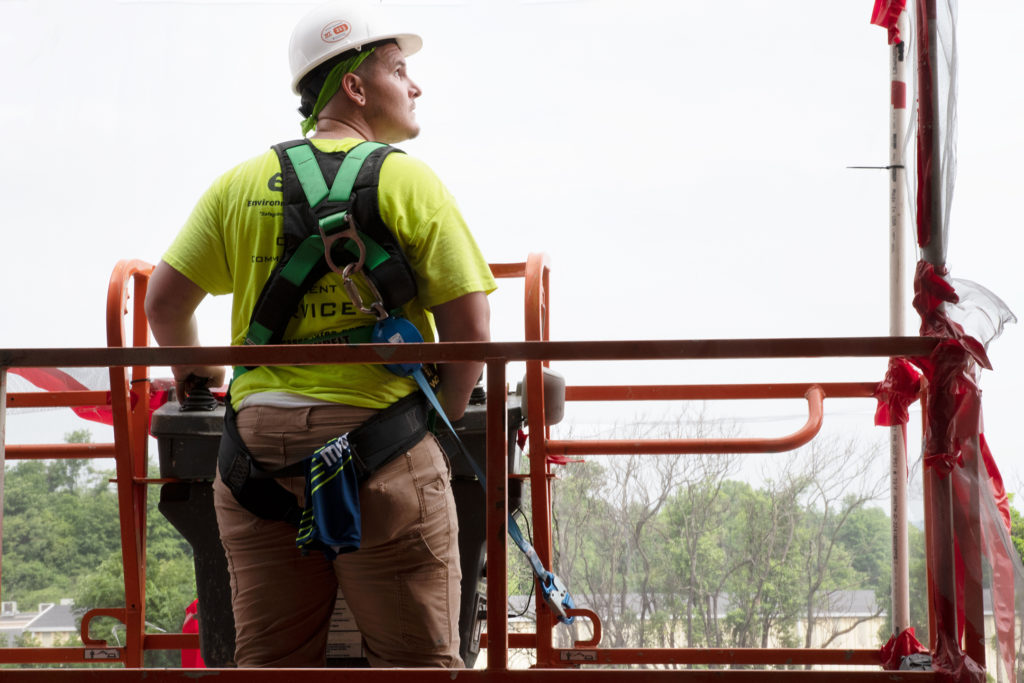
5. Get Some Shade
Potentially the most important tip out of the five, make sure to get some shade. Naturally, jobsites can get extremely hot in the summer months. Our Safety Director encourages all workers to take breaks in the shade to cool down and to be vigilant for signs of exhaustion, both for themselves and their co-workers on the jobsite. Having a buddy system may work well here. It is important to watch for the following signs of heat exhaustion and heat stroke for everyone on the job:
The Benefits of An Acclimatization Plan
Implementing an acclimatization plan is one way to prevent heat exhaustion. Simply put, this allows workers to get used to the high-heat conditions of the summer. This should take place over a one to two-week period. For new workers, the schedule should accommodate for no more than 20% exposure to heat on day one, with an increase of no more than 20% each day. If the worker has had experience on the job, you should do the same sort of process over a four-day period. Start day one at 50%, move to 60% on your second day, and 80% on your third day. By the fourth day you will be at 100% exposure. Tom supports this kind of plan if he feels the situation is right for it, although the tri-state area that D&B covers usually doesn’t require this since the seasons are well-balanced.
Trend 1: LEED and Green Building
“A ‘Green’ building is a building that, in its design, construction or operation, reduces or eliminates negative impacts, and can create positive impacts, on our climate and natural environment. Green buildings preserve precious natural resources and improve our quality of life” (WGBC). In response to the COVID-19 pandemic, Green or LEED construction is changing. The U.S. Green Building Council, creators of the LEED certification, plans to promote healthier and safer air quality indoors with adjusted certification criteria incentivizing the creation cleaner air systems. In 2021, there will be more building materials and components that help get LEED certification. One interesting and somewhat new development is a form of self-healing bio-concrete. This is a compound of concrete and bacteria that produces limestone when exposed to air and water, which helps with the impermeability of the surface. It costs around $240 per cubic meter. For reference, normal concrete usually costs between $200-$300, making it still cost efficient. Green building will continue to grow throughout the next decades and new technology and policy will come out to reinforce it as time goes by.
Trend 2: Modular Construction
The construction industry is rapidly moving towards modular materials because of its cost and time efficiency. Modular building is anywhere from 20% – 50% faster than traditional construction. It is also around 20% more cost efficient to build modular instead of traditional because of the reduced labor and time costs. Modular building also cuts the waste output almost in half due to optimal fabrication and pre-planned units. Everything is built off the construction site, which reduces the challenges of regular construction such as weather, limited working hours, and space. Overall, modular building is great for symmetrical and repeating buildings where sections can be made and stacked or attached to each other easily like in apartment or office buildings.
Trend 3: Safety
As it should be, safety is a huge trend in 2021. The old workplace safety system focused on recognizing problems and fixing them after someone gets hurt or a problem occurs. The new system getting pushed in the industry is based on prevention through education and training and recognizing issues before anyone gets hurt. This is why we have our Safety Committee meet monthly to discuss different topics of safety. Another large change in the safety category is better technology with Personal Protection Equipment (PPE). With more women entering the field, there is an increased awareness of the need for PPE to properly fit all employees to ensure safety. In addition, because of the COVID-19 pandemic there are policies across most companies including D&B that promote safe environments using masks, social distancing, and sanitization. When the pandemic hit, our team implemented a sign in and sign out sheet at every job site, making it easy for us to accurately perform contact tracing in the event that someone developed COVID-19 symptoms. D&B will continue to enforce this rule across all job sites moving forward. Learn more about our safety standards here.
Trend 4: Multi-Family
Multi-family construction is one of the fastest growing sectors of the commercial construction industry. Because of the lack of inventory in the housing market and changing demographics, multi-family construction is in high demand and will continue to grow in the following years. More people are looking for smaller, more affordable homes and condominiums with less maintenance than a normal single-family house. Research shows that 33% of people who are reaching age 55 are on their own. This is much different than what was the case 20 years ago. Currently D&B has multiple multi-family jobs under active construction and in the pre-construction phases. Throughout my internship, I shadowed the construction of The Reserve at Gring’s Mill, which you can view here.
Written by: D&B Intern, Alex Wolf
Alex culminated this list based on what he learned during his time at D&B. He is a Senior at Wilson High School who began shadowing various D&B employees in September of 2020. Alex will be attending Virginia Tech for Architecture in the Fall. “My internship experience at D&B made me realize that I want to pursue a career in residential remodeling and construction,” he explains. “I gained a lot of knowledge about the construction process and enjoyed being able to see entire construction projects from start to finish.”
In addition to celebrating International Women’s Day this Monday, we’ve also been celebrating Women in Construction Week here at D&B!
It’s no secret that construction is a male-dominated field. In fact, according to the U.S. Bureau of Labor Statistics, only about 10.3% of workers in the construction industry are women. This number has stayed nearly stagnant since the 1990s (see statistics below from the NAWIC):
Across the nation, there are over 1.1 million women in the construction industry. Meanwhile, in a drastic comparison, men come in just shy of 10 million at 9.9 million. Click here to see Construction Coverage’s list of cities with the most women in construction.
Another doubtful secret is that women in the construction industry are most likely to work in office positions. For example, men make up approximately 20% of office / admin roles in the industry, while women make up about 80%. In contrast, men make up nearly 100% of occupations in the construction, extraction, maintenance, and repair fields.
Resources for Women in the Industry
We’ve compiled a list of some of the D&B ladies’ favorite resources for women within the industry. Be sure to give their social channels a follow to receive a number of resources.
The National Association of Women in Construction is the leading association for women in construction. Its humble beginnings date back to 1953 when 16 women working in the industry founded what was then known as “Women in Construction of Fort Worth, Texas.” Their goal was to create a support network for women. The organization’s success led to it becoming a national charter in just two years. Today, this organization is still based in Fort Worth, however it has grown exponentially with over 115 chapters throughout the United States. They are committed to championing women to impact the direction of the construction industry, while also strengthening and amplifying the success of women in the industry. They do this by providing education, community and advocacy for women builders, professionals and tradeswomen in all aspects of the industry. According to NAWIC, “The focus of Women in Construction (WIC) Week is to highlight women as a viable component of the construction industry. WIC Week also provides an occasion for NAWIC’s thousands of members across the country to raise awareness for the opportunities available for women in the construction industry and to emphasize the growing role of women in the industry. It is also a time for local chapters to give back to their communities.” The northeast region of the U.S. has 16 NAWIC chapters, with one in Philadelphia and a second in South Central PA. Learn more about becoming a member here, and view their resources here.
If you missed our first blog post, be sure to check it out to learn all about Xena workwear for women. This company is all about inspiring girls to pursue careers in STEM and the trades… and did we mention they are OSHA compliant while also being comfortable and stylish?! No wonder the ladies at D&B love them so much. See below for a picture of D&B team members, Angela and Jessica, rocking their Xenas on the job site for Riverfront Federal Credit Union.
We also love the Women in Construction Summit Blog, which serves as a great resource for women in the industry. While you are at it, have you checked out Women Construction Owners & Executives USA (WCOE)? Located in Washington D.C., they aim to provide a network of executive women in the construction industry for mentorship, peer-to-peer assistance, information and support. Last but certainly not least, the Professional Women in Construction (PWC) is a nonprofit organization that works to support, advance, and connect women and promote diversity within the architecture, engineering, construction (AEC) and related industries. It all began in 1980 when eight women started attending industry events together in New York City. They knew their presence would be stronger together than individually. That same mentality resonates throughout the organization today throughout their five chapters located in New York, Boston, Connecticut, New Jersey and Philadelphia.
The D&B Ladies
True to the NAWIC’s mission, we wanted to highlight the talented, innovative and powerful women who make up the D&B team. We’d be remiss to end Women in Construction week without recognizing them. Learn more about them, their impressive accomplishments, their advice to other ladies looking to join the industry, and how they started working in construction in our Q&A below:
Meet Beth Varone-Barrer, Project Coordinator at our Reading Office
Time with D&B: Beth celebrated her 5 year anniversary with us in November.
How Beth Enhances our Team: Without Beth, we aren’t sure where we would be! She is such a vital part of our company, handling so many daily operations. She is loved by our clients who always have nothing but positive things to say about their experience with Beth and how helpful she is to them. Beth has a keen eye for design and helping our clients select the perfect options for their project.
Q: Did you always plan on being in this industry?
A: No. I realized I wanted to be in the industry when I started working at D&B. The energy was contagious, and I enjoyed seeing a vision come to life. I started as an Administrative Assistant for Al, Dan and Brennan. Jess McAllister would ask me to assist her with selections and research for projects, which I really enjoyed. When she moved on, she went to bat for me, and I was given an opportunity to assist with selections. From there, it grew into a Project Coordinator position. I was hooked. I love what I do!
Q: What do you love most about working in this industry and why?
A: The process and purpose! Someone has an idea, and our team brings it to life. There are many moving parts, and that keeps what I do interesting and never boring. I work with an exceptional group of experienced men and women that teach me something every day, and I appreciate that they share their knowledge with me. l enjoy continuously learning.
Q: If you could give your younger self one piece of advice what would it be?
A: If you want to, you can do anything!
Q: What is something you’ve accomplished since at D&B that you are most proud of?
A: I am a Project Coordinator! When I started with D&B, I did not realize that there was room to grow and advance. I am so grateful to Al, Dan and Brennan for giving me the opportunity to challenge myself and grow personally and professionally.
Q: Have your daughters and granddaughter ever shown interest in being in the same industry as you? What do they want to be when they grow up?
A: My daughter, Remington, is an EIT working for a firm in Malvern. I am so proud of her and how she has grown personally and professionally, learning to navigate in a male-dominated industry. I love that we have the industry in common, and of course she always teaches me something. Although my other two daughters are not in the industry, I would support their decision if they ever chose to work in construction. I am also very proud of the strong women they are! My advice to my three daughters is and has always been, “If you want to, you can do anything!” Guess what I tell my granddaughter? “If you want to, you can do anything!”
Meet Jessica Nelis, Operations Manager at our Reading Office
Time with D&B: Jessica is celebrating her four year anniversary with us in July!
How Jessica Enhances our Team: Jessica first joined us as a LEED AP certified Project Manager, with experience creating custom branded retail fixtures for renowned clients like Calvin Klein, Michael Kors Footwear, Birkenstock, and The North Face. She has managed projects ranging from single flagship stores to national rollouts, designing over two dozen Harley-Davidson showrooms from Juneau, Alaska to St. Augustine, Florida. Jessica has completed many impactful projects for clients such as Tower Health, Penn National Gaming, S&T Bank and more. After nearly 4 years as one of our Project Managers, Jessica recently shifted into a new role as our Operations Manager where her many skills as a management professional shine.
Q: Did you always plan on being in this industry?
A: Yes. Originally, I was looking to go into design. I graduated from Philadelphia University with a BS in Interior Design. I started my career there before moving over to the construction side of the field.
Q: What do you love most about working in this industry and why?
A: I like starting with a problem, working from a single idea, developing it into a full concept (which in turn is planned down to every detail) and then executing to bring a single basic concept into a tangible, physical building.
Q: Would you say there are more women in the industry since you first started? Why / why not?
A: It’s hard to say, but I just read an interesting opinion in Reading Eagle’s business section on the need to tap into women to fill a huge upcoming talent gap in the construction workforce, so I definitely feel like it will be more diverse in the next few years.
Q: What advice would you give to younger women / girls looking to join construction or any other trade / STEM career path?
A: Just because you’re the only woman in the room, doesn’t mean you don’t belong there!
Q: If you could give your younger self one piece of advice what would it be?
A: Be bold, take risks and speak up.
Q: What is something you’ve accomplished since at D&B that you are most proud of?
A: Taking on new challenges in both residential and commercial divisions, and being able to walk finished spaces with happy customers!
Q: What is something you’ve accomplished during your time in the industry that looking back you never knew you would?
A: Working with big brands to create retail store experiences throughout the country in high-end shopping malls, department stores, airports and in high-end shopping districts!
Q: Your favorite quote / piece of advice?
A: “Women need to shift thinking ‘I’m not ready to do that’ to thinking ‘I want to do that and I’ll learn by doing that.’” – Sheryl Sandberg, COO of Facebook
Meet Lesley Yocum, Project Manager at our Philadelphia Office
Time with D&B: Lesley just celebrated one year with Team D&B in February!
How Lesley Enhances our Team: Lesley came to D&B with 16 years of industry experience and a degree in Architectural Design from Lincoln Technical Institute. She has completed work for impressive clients like Morgan Stanley Children’s Hospital of New York, New York Presbyterian Hospital, Capital Health, and Inspira Health, to name a few.
Q: Did you always plan on being in this industry?
A: Yes and no. I studied and started my career in the Architectural field. After spending 15 years designing, I found that I enjoyed being on site more than in the office. I started to talk with my husband about the possibility of a career side step. It just so happened that D&B was hiring when I decided to move forward with the change. The stars aligned.
Q: What do you love most about working in this industry and why?
A: I enjoy the process. The planning, problem solving, seeing it come to life and ultimately the final product.
Q: What has been the hardest part of pursuing a career in construction, a field that is mostly male-dominated?
A: Respect from the older generation. Some are set in their ways. But respect is also earned, so it takes a bit of time sometimes, but we always get there.
Q: Would you say there are more women in the industry since you first started? Why / why not?
A: In the construction industry, sadly no. But I’ve only been here a year. In the Architectural side, YES! I have high hopes that it will start trickling over into construction.
Q: What advice would you give to younger women / girls looking to join construction or any other trade / STEM career path?
A: It’s a career that you can be proud of. Go for it!
Q: If you could give your younger self one piece of advice what would it be?
A: Always walk away knowing you did your best.
Q: Your favorite quote / piece of advice?
A: In a world where you can be anything, be kind.
Q: Has your daughter ever shown interest in being in the same industry as you? What does she want to be when she grows up?
A: My daughter builds! She will take all her toys and build a tower, castle or house. Her structures are detail-oriented, and she will build and rebuild something until it’s perfect to her. Currently, she’s four years old and wants to be a Mom.
Meet Angela Cremer, Marketing and Communications Coordinator at our Reading Office
Time with D&B: Angela has enjoyed being part of Team D&B for nearly 6 months now, having started in October 2020.
How Angela Enhances our Team: Angela is an ambitious and proactive communicator who tells D&B’s story through multiple channels. She graduated Summa Cum Laude from Albright College with a degree in Public Relations and Advertising.
Q: Did you always plan on being in this industry?
A: No. I majored in Public Relations and Advertising in college and have done marketing for a variety of different industries, from nonprofits to fashion. In 2017, I became the Director of Public Relations for a restoration company, also a more male-dominated industry like construction. Although I never really had a plan to enter the AEC industry, I have found there are countless opportunities, and I enjoy being part of it.
Q: What do you love most about working in this industry and why?
A: Each day is different. I love getting to go to our many job sites to document the process as our team transforms a rendering into reality. It’s a privilege to be able to share that process with the world. I have the upmost respect for our team members and everyone in the industry. They put in long days of hard work on the job site, either building something from the ground up or re-envisioning a pre-existing building into something to better benefit our communities.
Q: What has been the hardest part of pursuing a career in construction, a field that is mostly male-dominated?
A: I think a lot of women would agree that gender bias is more alive than most of us may want to admit this day in age. That’s one of the reasons I enjoy working here and in this industry. Even though most of my days are spent in the office, the days I do get out on the job site help to break down such biases. The more ladies that continue to enter this male-dominated industry, the more “normal” it will become to see a woman in a hard hat on the job.
Q: What advice would you give to younger women / girls looking to join construction or any other trade / STEM career path?
A: Glass ceilings are meant to be shattered. Don’t limit your goals and aspirations based on what is expected of you or considered the norm. Be the outlier. That’s how we create change.
Q: What is something you’ve accomplished during your time in the industry that looking back you never knew you would?
A: I’m relatively new to the team, but when I am out on a jobsite gathering footage I make it a priority to ask more questions. It is a goal of mine to become more well-versed in construction terminology. Just last week while at our active construction site for CHOP Souderton, our Superintendent John was more than happy to answer my questions and teach me a thing or two. I’m appreciative of our team members for taking the time to do that. This is how we collectively grow as a company.
Q: Your favorite quote / piece of advice?
A: “Some days it storms, some days it shines. This is how flowers grow.” This is my go to reminder that not every day is going to be great, and that’s necessary. We can’t appreciate the ups without the downs.
If you caught our social media post about Jessica’s suspiciously cute boots on our active jobsite at the future new headquarters for Riverfront Federal Credit Union, you are likely here to find out the official verdict from our Safety Committee Director, Tom.
The votes across our social platforms were pretty evenly split, but for those that know Jessica and know she would always put safety first, you win! For those still in denial that these shoes follow safety protocol, surprise! Jessica’s boots are both OSHA compliant and ASTM certified. (We know, we know… They looked way too cute to be). But we wouldn’t lie to you! They are I/75 C/75 steel-toe boots that are impact and compression resistant. They also have an oil and chemical resistant outsole that is completely slip resistant on dry and wet surfaces, too. Some of this brand’s products even have their electrical hazard certification for up to 18,000 volts!
If you are still in denial that these are steel toe boots, check out this video from our Safety Director, Tom, as he verifies that they meet safety standards. He also tells us what he originally thought when he first saw Jessica’s Xena boots on a job site.
So what are these nearly mythical boots called!? Not to worry – At D&B Construction Group, we’re all about efficiency and helping out our industry brothers and sisters. And that’s because we care. So of course, we will spill the beans about these handy full-grain leather boots. They are made by a company called Xena workwear for women. Best of all, they are made for women by women right here in the United States.
Xena workwear was founded as a result of the CEO’s own frustration from “working in a manufacturing environment where the only options were bulky, manly work boots.” Their CEO, Ana Kraft understands the importance of how what you wear can impact self-confidence and many other job-related factors that play a huge role in long-term career success.
So how did Jessica score these beauties?! It all happened about a year ago through a simple Google search. “I was searching for something better suited for me. I needed something more stylish that I could wear in the office,” she recalls. “I was also tired of the old, muddy, and uncomfortable boots I had been using for years.”
5 Stars for Xena
A year in, Jessica is more than happy with these shoes. “They are way more comfortable than the old shit kickers I had,” she says with a laugh. Jess has the Gravity Safety Shoe, which come in three other cute styles. They also make safety boots, like this pair that another one of our D&B team members, Angela, recently purchased for when she is on our active job sites.
Although new to the construction industry, Angela is already hooked and thankful Jessica made the recommendation. Meanwhile, Jessica has been with D&B Construction Group for nearly 4 years. She is an LEED AP certified Project Manager that has managed design and construction projects for some impressive buildings across the United States for well-known clients like Harley Davidson, Calvin Klein, The North Face, Birkenstock, and Michael Kors to name a few. Likewise, Jess has also completed many impactful projects locally for Tower Health, Penn National Gaming, Hottenstein Orthodontics, S&T Bank, Gold’s Gym and more.
Both ladies regularly have to leave the office to head out on the jobsite. “Not having to worry about changing shoes as I go back and forth between the office and job sites just makes my day to day easier,” says Jessica. As a vital part of D&B’s operations here at the office, Jessica’s Xena’s have been a game changer in her day to day by making it easy to transition from office to job site.
“These boots are so comfortable that I sometimes forget I’m wearing them once I get back from a job site,” she explained. And it is no wonder, since they feature comfortable ankle padding, a lightweight design, breathable lining with air-flow tech, and an impact absorbing insole. Plus, just look at how on point their packaging and branding is! Xena boots even come with a card verifying that they are OSHA compliant and ASTM certified. This may definitely come in handy for those that think your shoes are too stylish to also be safe on the job.
Be sure to pass this brand along to other women in construction and other STEM-related careers. Ladies: Check out Xena’s Facebook group Xena Moves. This group was created for women in STEM and the Trades who are looking for a safe haven to connect with like-minded professionals and to share fun work style ideas! This is how the Team D&B ladies wear their #xenasatwork:
PS: For those of you who may have guessed wrong about Jessica’s boots being OSHA compliant – Don’t fret! “I get questioned all the time,” she says. “People ask me if they are legit, and I just encourage them to step on my toes.”
